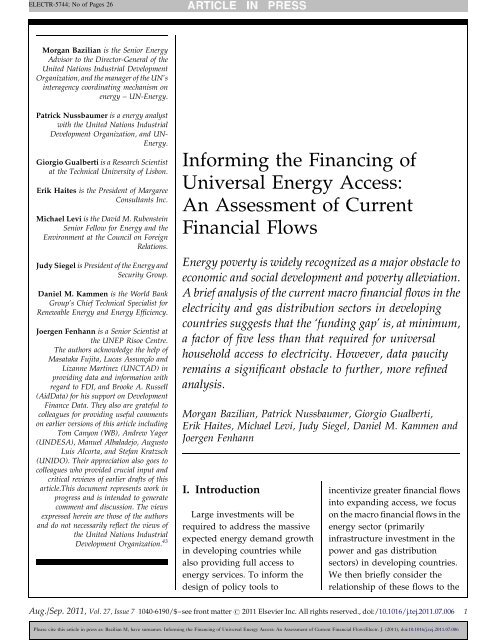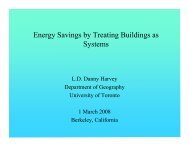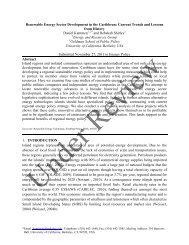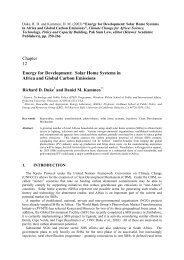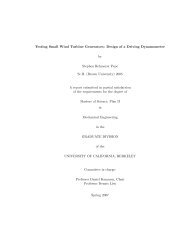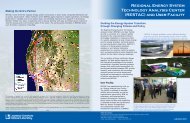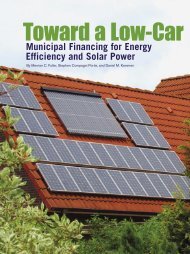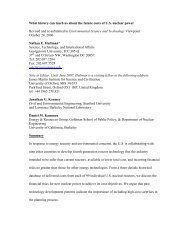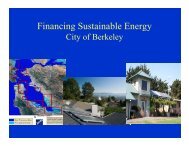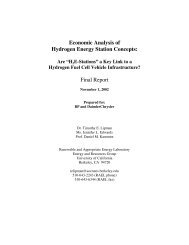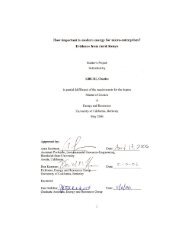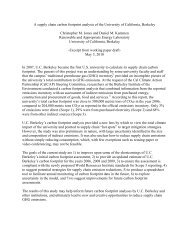Informing the Financing of Universal Energy Access: An Assessment ...
Informing the Financing of Universal Energy Access: An Assessment ...
Informing the Financing of Universal Energy Access: An Assessment ...
Create successful ePaper yourself
Turn your PDF publications into a flip-book with our unique Google optimized e-Paper software.
ELECTR-5744; No <strong>of</strong> Pages 26Morgan Bazilian is <strong>the</strong> Senior <strong>Energy</strong>Advisor to <strong>the</strong> Director-General <strong>of</strong> <strong>the</strong>United Nations Industrial DevelopmentOrganization, and <strong>the</strong> manager <strong>of</strong> <strong>the</strong> UN’sinteragency coordinating mechanism onenergy – UN-<strong>Energy</strong>.Patrick Nussbaumer is a energy analystwith <strong>the</strong> United Nations IndustrialDevelopment Organization, and UN-<strong>Energy</strong>.Giorgio Gualberti is a Research Scientistat <strong>the</strong> Technical University <strong>of</strong> Lisbon.Erik Haites is <strong>the</strong> President <strong>of</strong> MargareeConsultants Inc.Michael Levi is <strong>the</strong> David M. RubensteinSenior Fellow for <strong>Energy</strong> and <strong>the</strong>Environment at <strong>the</strong> Council on ForeignRelations.Judy Siegel is President <strong>of</strong> <strong>the</strong> <strong>Energy</strong> andSecurity Group.Daniel M. Kammen is <strong>the</strong> World BankGroup’s Chief Technical Specialist forRenewable <strong>Energy</strong> and <strong>Energy</strong> Efficiency.Joergen Fenhann is a Senior Scientist at<strong>the</strong> UNEP Risoe Centre.The authors acknowledge <strong>the</strong> help <strong>of</strong>Masataka Fujita, Lucas Assunção andLizanne Martinez (UNCTAD) inproviding data and information withregard to FDI, and Brooke A. Russell(AidData) for his support on DevelopmentFinance Data. They also are grateful tocolleagues for providing useful commentson earlier versions <strong>of</strong> this article includingTom Canyon (WB), <strong>An</strong>drew Yager(UNDESA), Manuel Albaladejo, AugustoLuis Alcorta, and Stefan Kratzsch(UNIDO). Their appreciation also goes tocolleagues who provided crucial input andcritical reviews <strong>of</strong> earlier drafts <strong>of</strong> thisarticle.This document represents work inprogress and is intended to generatecomment and discussion. The viewsexpressed herein are those <strong>of</strong> <strong>the</strong> authorsand do not necessarily reflect <strong>the</strong> views <strong>of</strong><strong>the</strong> United Nations IndustrialDevelopment Organization. 43<strong>Informing</strong> <strong>the</strong> <strong>Financing</strong> <strong>of</strong><strong>Universal</strong> <strong>Energy</strong> <strong>Access</strong>:<strong>An</strong> <strong>Assessment</strong> <strong>of</strong> CurrentFinancial Flows<strong>Energy</strong> poverty is widely recognized as a major obstacle toeconomic and social development and poverty alleviation.A brief analysis <strong>of</strong> <strong>the</strong> current macro financial flows in <strong>the</strong>electricity and gas distribution sectors in developingcountries suggests that <strong>the</strong> ‘funding gap’ is, at minimum,a factor <strong>of</strong> five less than that required for universalhousehold access to electricity. However, data paucityremains a significant obstacle to fur<strong>the</strong>r, more refinedanalysis.Morgan Bazilian, Patrick Nussbaumer, Giorgio Gualberti,Erik Haites, Michael Levi, Judy Siegel, Daniel M. Kammen andJoergen FenhannI. IntroductionLarge investments will berequired to address <strong>the</strong> massiveexpected energy demand growthin developing countries whilealso providing full access toenergy services. To inform <strong>the</strong>design <strong>of</strong> policy tools toincentivize greater financial flowsinto expanding access, we focuson <strong>the</strong> macro financial flows in <strong>the</strong>energy sector (primarilyinfrastructure investment in <strong>the</strong>power and gas distributionsectors) in developing countries.We <strong>the</strong>n briefly consider <strong>the</strong>relationship <strong>of</strong> <strong>the</strong>se flows to <strong>the</strong>Aug./Sep. 2011, Vol. 27, Issue 7 1040-6190/$–see front matter # 2011 Elsevier Inc. All rights reserved., doi:/10.1016/j.tej.2011.07.006 1Please cite this article in press as: Bazilian M, have surnames. <strong>Informing</strong> <strong>the</strong> <strong>Financing</strong> <strong>of</strong> <strong>Universal</strong> <strong>Energy</strong> <strong>Access</strong>: <strong>An</strong> <strong>Assessment</strong> <strong>of</strong> Current Financial FlowsElectr. J. (2011), doi:10.1016/j.tej.2011.07.006
ELECTR-5744; No <strong>of</strong> Pages 26issue <strong>of</strong> energy poverty (see IEA,2010; Bazilian et al., 2010a,b). Wefind that <strong>the</strong> financial flowsrelated to <strong>the</strong> energy sector indeveloping countries aresignificant, but still inadequate to<strong>the</strong> task <strong>of</strong> delivering energyaccess to those who lack it.Ultimately, this research ispresented to inform future moredetailed analysis.W e build on <strong>the</strong>methodology devised toquantify <strong>the</strong> flows <strong>of</strong> investmentin <strong>the</strong> climate change area(UNFCCC, 2007). Thismethodology relies on nationalgross fixed capital formation,overseas development assistance,and foreign direct investment. Webegin by providing a sense <strong>of</strong>scale by considering recent and‘‘iconic’’ investment figures in <strong>the</strong>policy realm in Section II. Wedescribe <strong>the</strong> methodology appliedto estimate <strong>the</strong> financial flows in<strong>the</strong> energy sector in Section III. InSection IV, we present pasttrends. We <strong>the</strong>n discuss somelinks with energy poverty inSection V. Section VI outlinesfur<strong>the</strong>r work required to advancethis research agenda.II. ‘Beautiful Numbers’Several iconic investmentfigures are informing policydecisions related to internationalenergy and climate change policy.High-level aggregated figures like<strong>the</strong>se are important to provide ageneral sense <strong>of</strong> scale. However,<strong>the</strong>se ‘‘beautiful numbers’’ aredifficult to compare and thus <strong>of</strong>tenconfuse ongoing discussions.Figure 1 depicts 10 such globalinvestment figures, ranging frompresent energy investments (on<strong>the</strong> left), to projections <strong>of</strong> futureenergy infrastructure investment,to estimates <strong>of</strong> <strong>the</strong> cost <strong>of</strong>delivering universal energy accessand <strong>of</strong> meeting global climatechange goals. We briefly consider<strong>the</strong>se figures in order to provideadditional transparency andclarity, and to help frame ourfinancial flows analysis. The figurepresents <strong>the</strong> power sector aspect <strong>of</strong>each analysis as this sector isclosest to <strong>the</strong> data sets that weexplore for financial flows. 1,2,3,4,5These figures, as valuable as<strong>the</strong>y might be, are difficult tointerpret and compare for anumber <strong>of</strong> reasons, including: Different methodologiesemployed, Different country coverage, Different definitions forinvestments or flows, and Different sectors covered. different end years foranalysis averages vs. individual years actual vs. projectionsWhat is clear, however, is thatcurrent estimates <strong>of</strong> <strong>the</strong>investments required to provideuniversal access to energyservices are considerably lowerthan projected investments in <strong>the</strong>energy sector in general or <strong>the</strong>estimated need for additionalinvestment in ambitious climatechange mitigation scenarios.III.MethodologyThere is an extensive literatureon international financial flows todeveloping countries, mostlygoing beyond <strong>the</strong> core <strong>of</strong> thisanalysis (see, e.g., Albuquerque,2003; Asiedu, 2002; Bahmani-Oskooee, 1986; Barnett, 1993; Bird,1981; Claessens and Schmukler,2007; Fung, 2009; Gelos et al., 2011;Kasuga, 2007; Kim, 2000; Kinda,2010; Knight, 1998; Laureti andPostiglione, 2005; McGillivray,1989; Mishkin, 2009; Mody andMurshid, 2005; Munduch andWeinberg, 1979; Noorbakhsh et al.,2001; Odedokun, 1996; Rao, 1997;Sadik and Bolbol, 2001; Singh andZammit, 2000; Steel et al., 1997).Data on current financial flowsto <strong>the</strong> energy sector generally stemfrom ei<strong>the</strong>r aggregated global orregional estimates, or scatteredand un-processed datasets(Olbrisch et al., 2011). The principalobstacle in this analysis stems fromdata paucity, particularly in <strong>the</strong>case <strong>of</strong> developing and leastdeveloped countries (LDC). Inparticular, <strong>the</strong>re is nocomprehensive assessment <strong>of</strong> <strong>the</strong>current financial flows to addressenergy poverty. We utilize various2 1040-6190/$–see front matter # 2011 Elsevier Inc. All rights reserved., doi:/10.1016/j.tej.2011.07.006 The Electricity JournalPlease cite this article in press as: Bazilian M, have surnames. <strong>Informing</strong> <strong>the</strong> <strong>Financing</strong> <strong>of</strong> <strong>Universal</strong> <strong>Energy</strong> <strong>Access</strong>: <strong>An</strong> <strong>Assessment</strong> <strong>of</strong> Current Financial FlowsElectr. J. (2011), doi:10.1016/j.tej.2011.07.006
ELECTR-5744; No <strong>of</strong> Pages 26Figure 1: ‘Beautiful Numbers’ in <strong>the</strong> <strong>Energy</strong> and Climate Space(Bar 1: New investment in renewable energy globally in 2009 amounted toUSD 162 billion (UNEP, SEFI, and BNEF, 2010), including R&D and bi<strong>of</strong>uels. The figure most closely related to <strong>the</strong> data on financial flows in <strong>the</strong>power sector is likely that <strong>of</strong> asset finance <strong>of</strong> new, utility-scale renewable energy projects. This was estimated at USD 100.9 billion in 2009.Bar 2: Global investment in electricity, gas distribution, and water supply in 2000 totaled USD 257 billion, <strong>of</strong> which USD 52 billion and USD 2.3billion was invested in non-<strong>An</strong>nex I 2 and Least Developed Countries (LDC) (UNFCCC, 2007), respectively. We use a figure <strong>of</strong> USD 216 billion in<strong>the</strong> chart, which (approximately) removes <strong>the</strong> water supply element from <strong>the</strong> total. Bar 3: IEA (2003) estimated investment in energy globally in2000 at USD 431 billion for energy, including USD 235 billion for electricity. Bar 4: Fossil fuel subsidies were calculated to be USD 312 billion(G20, 2010). 3 This estimate uses 2009 prices and thus differs from 2008 estimates <strong>of</strong> USD 558 billion (G20, 2010). The figure is USD 95 billionfor electricity subsidies. Bar 5: Looking to <strong>the</strong> future, IEA (2010) projects <strong>the</strong> investment cost for energy supply infrastructure between 2010and 2035 to be USD 32,816 billion globally under its ‘‘New Policy Scenario.’’ 4 To that, a fur<strong>the</strong>r USD 13,500 billion would be needed for strongclimate mitigation. For electricity alone, USD 16,606 billion is expected to be needed globally, with USD 6,477 billion in OECD and USD 10,130billion and non-OECD countries. For <strong>the</strong> purposes <strong>of</strong> this graph we have simply converted <strong>the</strong>se numbers to annual figures by averaging <strong>the</strong>macross <strong>the</strong> time period. 5 Bar 6: The WEF/BNEF figures reflect future projections to 2030 for clean energy minus <strong>the</strong> projections for bi<strong>of</strong>uels (seeWEF, 2010 – Figure 4). Bars 7 and 8: The promised fast-start financing under <strong>the</strong> Copenhagen Accord represents USD 10 billion annuallybetween 2010 and 2012. Fur<strong>the</strong>r, developed country parties committed to a goal <strong>of</strong> mobilizing jointly USD 100 billion per year by 2020 toaddress <strong>the</strong> needs <strong>of</strong> developing countries. (Roughly half that amount would go to adaptation). Bars 9 and 10: IEA, UNDP, and UNIDO (2010)estimate <strong>the</strong> cost <strong>of</strong> universal energy access at USD 756 billion between 2010 and 2035, whereas Bazilian et al. (2010) find a cumulative USD1,500 billion to 2030 in <strong>the</strong>ir ‘high’ scenario. Again, both figures are averaged over <strong>the</strong> period to present annual figures.sources to help address thisanalytical gap.W e focus on electricityproduction and gasdistribution, which represents one<strong>of</strong> <strong>the</strong> dozen or so o<strong>the</strong>r sectorsdetailed in financial flow datasets. 6 Still, resource-richdeveloping countries are also <strong>the</strong>target <strong>of</strong> growing investments in<strong>the</strong> upstream energy sector <strong>of</strong> oil,coal, and gas extraction andprocessing (see Section III.B.1). 7These investments are targetedmainly to <strong>the</strong> export sector and arenot directly linked with <strong>the</strong> energyaccess infrastructure, thus <strong>the</strong>y arenot considered in this analysis. 8W e draw heavily on <strong>the</strong>precedent created toevaluate <strong>the</strong> investment andfinancial flows in <strong>the</strong> climatechange space, notably <strong>the</strong>methodology applied inAug./Sep. 2011, Vol. 24, Issue 7 1040-6190/$–see front matter # 2011 Elsevier Inc. All rights reserved., doi:/10.1016/j.tej.2011.07.006 3Please cite this article in press as: Bazilian M, have surnames. <strong>Informing</strong> <strong>the</strong> <strong>Financing</strong> <strong>of</strong> <strong>Universal</strong> <strong>Energy</strong> <strong>Access</strong>: <strong>An</strong> <strong>Assessment</strong> <strong>of</strong> Current Financial FlowsElectr. J. (2011), doi:10.1016/j.tej.2011.07.006
ELECTR-5744; No <strong>of</strong> Pages 26UNFCCC (2007). We complement<strong>the</strong> existing literature by: Increasing <strong>the</strong> granularity interms <strong>of</strong> geographical coverageand providing data at <strong>the</strong> nationallevel for energy investments; Refining existing estimateswith additional informationfrom various complementarysources; and Providing an update on <strong>the</strong>existing figures by using <strong>the</strong> mostrecent available datasets.A. Flows consideredOur estimates are based on datafor a number <strong>of</strong> complementaryflows: Gross Fixed CapitalFormation 9 (GFCF), ForeignDirect Investments 10 (FDI), andOfficial Development Finance 11(ODF). (Appendix A providesdetailed national energy-relatedGFCF accounts. Appendix Bprovides supplementaryinformation with regard to energyinvestments in <strong>the</strong> CleanDevelopment Mechanism (CDM),merely as a point <strong>of</strong> comparison.)Table 1 presents a generaloverview <strong>of</strong> <strong>the</strong> financial flowsconsidered in this analysis. GFCFrepresents <strong>the</strong> total investmentflow. We include FDI and ODF toadd richness to <strong>the</strong> analysis. 12N ational and internationalstatistics <strong>of</strong>fices do notgenerally record <strong>the</strong> yearlyamount <strong>of</strong> domestic andinternational finance directed at<strong>the</strong> energy sector; available datathus present severe limitations. Weapply basic statistical tools toestimate missing values, andemploy several techniques to treatTable 1: Overview <strong>of</strong> Investment Flow Data. aType <strong>of</strong> flow Data source RemarkTotalGFCF UNSTAT b and WDI c Data include waterInternationalFDI UNCTAD Data include waterODFAidData da NFCCC (2007) also includes international debt as a source <strong>of</strong> financing for <strong>the</strong> energy, gas and water sector and anestimation <strong>of</strong> <strong>the</strong> source <strong>of</strong> <strong>the</strong> investment (households, corporations, government) for <strong>the</strong> total <strong>of</strong> all sectors (tables IV-8 and III-2, respectively). These data are <strong>the</strong> results <strong>of</strong> an economic model built for <strong>the</strong> year 2000. We estimate GFCF asa time series to obtain insights on trends.b UNSD (n.d.).c WB (n.d.).d Findley et al. (2010).<strong>the</strong> available data. The sectionbelow provides a detailedoverview <strong>of</strong> <strong>the</strong> data treatment foreach flow. All data are convertedinto USD 2000 using GDP deflatorsand exchange rates. 13 We focus on<strong>the</strong> timeframe 2000–2009, andutilize data from project leveldatabases (ODF and PrivateParticipation in Infrastructuredatabase 14 (PPI)) and data fromNational Accounts (GFCF andFDI). We recognize thatinvestment decisions in <strong>the</strong> projectlevel database may not reflectimmediately in <strong>the</strong> nationalaccounts, or may generate multiyearflows.1. GFCFGFCF data are aggregated forspecific sectors and/or for <strong>the</strong>entire economy. Here we areinterested in electricity, gasdistribution, and water supply, forwhich data are available only forselected countries. 15 For <strong>the</strong>countries with incomplete timeseries for this sector, we use <strong>the</strong>average national share from <strong>the</strong>years for which data is availableand compute <strong>the</strong> missing onesbased on <strong>the</strong> total GFCF for yearswhere it is not. Where sectorspecificdata are missingaltoge<strong>the</strong>r, we use a weightedaverage share <strong>of</strong> GFCF forelectricity, gas distribution, andwater supply over <strong>the</strong> total (3.8percent and 8.1 percent for OECDand non-OECD, respectively) andcompute it as a best approximationfor <strong>the</strong> missing national data. 16 It isimportant to note that that GFCFdata are based on nationalaccounts’ definitions <strong>of</strong> sectors,and <strong>the</strong>refore electricity, gasdistribution, and water are includedin <strong>the</strong> same sector. Comprehensivedatasets distinguishing <strong>the</strong> watercomponent from electricity, and gasdistribution do not exist. Weexclude <strong>the</strong> water component bysubtracting it from <strong>the</strong> total basedon <strong>the</strong> ratios 17 available inUNFCCC (2007), which are basedon OECD data.V arious investments in coal,oil, and gas production,processing, and transportationfacilities are spread across o<strong>the</strong>rsectors in <strong>the</strong> national accounts –mining and quarrying, industry,and transportation etc. – whichalso include o<strong>the</strong>r facilities.Therefore, compiling data on4 1040-6190/$–see front matter # 2011 Elsevier Inc. All rights reserved., doi:/10.1016/j.tej.2011.07.006 The Electricity JournalPlease cite this article in press as: Bazilian M, have surnames. <strong>Informing</strong> <strong>the</strong> <strong>Financing</strong> <strong>of</strong> <strong>Universal</strong> <strong>Energy</strong> <strong>Access</strong>: <strong>An</strong> <strong>Assessment</strong> <strong>of</strong> Current Financial FlowsElectr. J. (2011), doi:10.1016/j.tej.2011.07.006
ELECTR-5744; No <strong>of</strong> Pages 26investment in coal, oil, and gassupply from national accounts ischallenging. Also, <strong>the</strong> extractivesectors are <strong>of</strong>ten export-oriented,and <strong>the</strong> link with national energyaccess is <strong>the</strong>refore weaker.None<strong>the</strong>less, cumulativeinvestment in coal, oil, and gas isroughly equivalent to powersector investment (see, e.g., IEA,2010). Finally, we have excluded anumber <strong>of</strong> countries or subnationalentities 18 from <strong>the</strong>analysis for various reasons (e.g.,statistical anomalies, lack <strong>of</strong> data).2. FDIFDI data are available inaggregate and by sector, includingfor electricity, gas distribution, andwater. We only consider FDIinflows, as our interest lies in <strong>the</strong>investments in particularcountries. 19 In general, <strong>the</strong> datasetsare relatively ‘‘patchy.’’ Ra<strong>the</strong>rthan trying to extrapolate <strong>the</strong>figures based on bold assumptionsto cover for <strong>the</strong> missing data, wefocus our analysis on a subset <strong>of</strong>countries for which <strong>the</strong> data isavailable. 20 Thus we do not presentan aggregated time-series, as wedo for GFCF and ODF.W e use a complementarydatabase, <strong>the</strong> PrivateParticipation in InfrastructureDatabase, 21 which collects dataseparately for projects in <strong>the</strong> energyand water sectors, to evaluate <strong>the</strong>proportion <strong>of</strong> investment in each <strong>of</strong>energy and water, which we <strong>the</strong>napply to isolate <strong>the</strong> watercomponent. We find that at <strong>the</strong>global level, between 2000 and2008, <strong>the</strong> investment in <strong>the</strong> watersector was approximately 10percent <strong>of</strong> <strong>the</strong> total, althoughnational shares can differsignificantly. Unfortunately,UNCTAD does not differentiatebetween ‘‘greenfield’’ and mergersand acquisitions flows; in o<strong>the</strong>rwords, <strong>the</strong>re is no means todistinguish between investmentsin new projects and financialtransactions not leading toadditional assets.3. ODFOfficial Development Financedata is available for <strong>the</strong> energysector and its sub-components,including energy policy,renewable sources, nonrenewablesources, and o<strong>the</strong>rs.The source used, AidData(Findley et al., 2010), contains all<strong>the</strong> data included in <strong>the</strong> CreditorReporting System (CRS) database<strong>of</strong> <strong>the</strong> OECD and adds greatercoverage <strong>of</strong> multilateralorganizations and <strong>of</strong> non-OECDdonors. 22 We include onlyprojects related to <strong>the</strong> energysector, following <strong>the</strong>methodology applied in OECD(2010b), 23 and exclude refinancingloans. It must be noted that ODF(or ODA) are commitmentsproclaimed by <strong>the</strong> donors, notactual flows. 24IV. <strong>Financing</strong> <strong>Energy</strong>:Past Trends<strong>Financing</strong> for <strong>the</strong> energy sectoris obviously contingent on trendsin overall capital flows. The recentfinancial crisis affecteddeveloping countries in a number<strong>of</strong> ways. Notably, it hurt exportrevenues, caused remittances todecline, and ODA is likely t<strong>of</strong>ur<strong>the</strong>r suffer from <strong>the</strong>retrenchment <strong>of</strong> donor countries(UN, 2011). While we focus onGFCF, Foreign Direct Investment,and Official DevelopmentFinance, o<strong>the</strong>r capital flows, inparticular portfolio investments(debt and equity) and short- andlong-term private bank lendingwill provide additional finance to<strong>the</strong> energy sector.A. Gross Fixed CapitalFormationTo provide a sense <strong>of</strong> scale, it isuseful to consider energy-relatedinvestment in relation to globalinvestment. The share <strong>of</strong> GFCF forenergy represented 2.8 percent <strong>of</strong><strong>the</strong> total in 2000, with <strong>the</strong> largestshares being wholesale retailtrade (34 percent), manufacturing(17 percent), and construction (11percent). 25Global GFCF for electricity andgas distribution (detailed data fordeveloping countries in TableA1.1 <strong>of</strong> Appendix A) has beenrising steadily throughout <strong>the</strong>past decade, with <strong>the</strong> notableAug./Sep. 2011, Vol. 24, Issue 7 1040-6190/$–see front matter # 2011 Elsevier Inc. All rights reserved., doi:/10.1016/j.tej.2011.07.006 5Please cite this article in press as: Bazilian M, have surnames. <strong>Informing</strong> <strong>the</strong> <strong>Financing</strong> <strong>of</strong> <strong>Universal</strong> <strong>Energy</strong> <strong>Access</strong>: <strong>An</strong> <strong>Assessment</strong> <strong>of</strong> Current Financial FlowsElectr. J. (2011), doi:10.1016/j.tej.2011.07.006
ELECTR-5744; No <strong>of</strong> Pages 26Table 2: Overview <strong>of</strong> GFCF for Electricity and Gas Distribution (USD billion) [constant 2000 prices].2000 2001 2002 2003 2004 2005 2006 2007 2008 2009 aOECD 179.1 183.0 175.1 174.3 168.3 173.3 191.8 211.6 222.7 172.2Non-OECD b 53.5 58.3 60.1 71.2 77.0 84.8 98.1 123.4 153.4 144.5LDC 1.3 1.4 1.6 1.6 1.7 1.9 2.0 2.3 2.5 2.6Global 232.6 241.3 235.2 245.5 245.3 258.1 289.9 335.0 376.1 316.6a Incomplete; <strong>the</strong> sharp decrease is due to <strong>the</strong> economic crisis as well as to <strong>the</strong> fact that <strong>the</strong> dataset is incomplete at <strong>the</strong> date <strong>of</strong> writing.b This row includes <strong>the</strong> LDC figures.exception <strong>of</strong> 2009 (Table 2). At <strong>the</strong>regional level, <strong>the</strong> trends aresimilar, although not quite asclear-cut. GFCF for electricity andgas distribution in <strong>the</strong> OECD wasstagnant or decreasing between2000 and 2005, before picking upsharply. In <strong>the</strong> LDCs, GFCF inelectricity and gas distributionhas doubled in a decade, although<strong>the</strong> absolute value remains low.B y way <strong>of</strong> comparison, IEA(2003) estimated <strong>the</strong> worldinvestment in electricity and gas 26in 2000 at USD 315 billion.UNFCCC (2007) estimated, basedon UNCTAD and OECD data, <strong>the</strong>investment in electricity and gasdistribution reaching USD 216billion in 2000. Eberhard et al.(2011) also provide very usefulanalysis on investment in 24countries <strong>of</strong> sub-Saharan Africa(SSA). 27Figure 2 shows <strong>the</strong> relativeevolution in energy-related GFCFin selected 28 developing countries.The country datasets arenormalized in 2000 to reveal <strong>the</strong>trends in <strong>the</strong> recent years. Thecurves for Namibia and, to a lesserextent, Armenia, urge for cautionin interpreting <strong>the</strong> data, since <strong>the</strong>flows are subject to significantfluctuations, particularly if <strong>the</strong>yare relatively small in absoluteterms. Also, wide variations urgefor caution in <strong>the</strong> interpretation <strong>of</strong><strong>the</strong> datasets.T his notwithstanding, <strong>the</strong>analysis indicates a clearpositive trend overall. That beingnoted, <strong>the</strong> rate <strong>of</strong> increase variesgreatly between <strong>the</strong> countries(+60 percent and +160 percent forBotswana and India, respectively,over 10 years). Interestingly, <strong>the</strong>trend is in some cases negative, asFigure 2: Relative Trends in <strong>Energy</strong>-Related GFCF in Selected Developing Countries [constant 2000 USD]6 1040-6190/$–see front matter # 2011 Elsevier Inc. All rights reserved., doi:/10.1016/j.tej.2011.07.006 The Electricity JournalPlease cite this article in press as: Bazilian M, have surnames. <strong>Informing</strong> <strong>the</strong> <strong>Financing</strong> <strong>of</strong> <strong>Universal</strong> <strong>Energy</strong> <strong>Access</strong>: <strong>An</strong> <strong>Assessment</strong> <strong>of</strong> Current Financial FlowsElectr. J. (2011), doi:10.1016/j.tej.2011.07.006
ELECTR-5744; No <strong>of</strong> Pages 26in <strong>the</strong> instance <strong>of</strong> Niger.Noteworthy is also <strong>the</strong> case <strong>of</strong>South Africa, where energyrelatedGFCF increasedexponentially in recent years.Incidentally, South Africa is one<strong>of</strong> <strong>the</strong> <strong>of</strong>ten-quoted success storieswith regard to rapidly increasing<strong>the</strong> rate <strong>of</strong> access to electricity.B. Foreign Direct InvestmentElectricity, gas, and waterrepresents one <strong>of</strong> 15 sub-sectors inFDI data sets, including, inter alia,financial intermediation; paperand paper products; food,beverage, and tobacco. As noted,because <strong>of</strong> <strong>the</strong> difficulty in <strong>the</strong>robustness <strong>of</strong> <strong>the</strong> FDI data sets,we do not present a time-series <strong>of</strong>aggregated figures. However, asan example, we estimated <strong>the</strong>total 2000 flows to be 30 USDbillion. 29 Foreign directinvestment grew steadily fordeveloped and developingeconomies over recent years until<strong>the</strong> global financial crisis <strong>of</strong> 2008.The effect <strong>of</strong> <strong>the</strong> crisis on FDI wasevident in 2009, and was morepronounced in richer nations thanfor developing economies. Abouthalf <strong>of</strong> global FDI inflows now goto developing countries andtransition economies (UNCTAD,2010). While <strong>the</strong> overall trends forFDI inflows in LDCs have been on<strong>the</strong> rise for <strong>the</strong> last decade(UNCTAD, 2011), our analysisshows a downward tendency forenergy-related 30 FDI inflows inthose countries (see Figure 3 forseveral examples).P roviding insights on trendsby region over time ischallenging given <strong>the</strong> datapaucity; no clear pattern can bederived from an analysis acrossdeveloping countries, as <strong>the</strong>energy-related FDI inflows varywidely between <strong>the</strong> years. Indeed,<strong>the</strong> flows have little ‘‘inertia’’ andare strongly influenced byindividual projects.C. Official DevelopmentFinanceAid for energy has been part <strong>of</strong>bilateral and multilateral aideffort for many years. Its level wasrelatively constant in <strong>the</strong> 1980sbefore decreasing deeply <strong>the</strong>following decade and reaching aminimum around <strong>the</strong> year 2000; ithas been on <strong>the</strong> rise again since(Figure 4). For <strong>the</strong> years 2000–08,<strong>the</strong> categories that received <strong>the</strong>bulk <strong>of</strong> <strong>the</strong> energy relateddevelopment finance were <strong>Energy</strong>Policy 31 (35 percent), followed byElectrical Transmission(26 percent), and Non-Renewable<strong>Energy</strong> (17 percent).Figure 3: <strong>Energy</strong>-Related (plain lines) and Total (doted lines) Inward FDI Flows for Selected LDC Countries [constant 2000 USD]Aug./Sep. 2011, Vol. 24, Issue 7 1040-6190/$–see front matter # 2011 Elsevier Inc. All rights reserved., doi:/10.1016/j.tej.2011.07.006 7Please cite this article in press as: Bazilian M, have surnames. <strong>Informing</strong> <strong>the</strong> <strong>Financing</strong> <strong>of</strong> <strong>Universal</strong> <strong>Energy</strong> <strong>Access</strong>: <strong>An</strong> <strong>Assessment</strong> <strong>of</strong> Current Financial FlowsElectr. J. (2011), doi:10.1016/j.tej.2011.07.006
ELECTR-5744; No <strong>of</strong> Pages 26Figure 4: Development Finance for <strong>the</strong> <strong>Energy</strong> Sector by Purpose; Commitments, 1980-2008, Using 3-Year Moving Averages [constant2000 USD]T here has been an almostcontinuous increase inelectricity-related ODF in non-OECD countries during recentyears. However, ODF to LDCs hasvaried widely over <strong>the</strong> years; it isnone<strong>the</strong>less also on an increasingtrend (Table 3).D. Relationship betweenGFCF, FDI, and ODA/FA number <strong>of</strong> scholars havelooked into <strong>the</strong> relationshipbetween ODA/F, FDI, and GFCF.Obviously, <strong>the</strong> effect <strong>of</strong> FDI oncapital formation largely dependson whe<strong>the</strong>r FDI is directed togreenfield projects as opposed tocross-border mergers andacquisitions. Several authors haveinvestigated <strong>the</strong> relation betweenFDIs and Official DevelopmentAssistance. UNCTAD notes that,especially in least developedcountries, FDIs tend to concentrateon <strong>the</strong> primary sector (mining)until a sufficient level <strong>of</strong> capabilityand infrastructure are built. In thiscontext LDCs could leverage ODAfor improving <strong>the</strong> conditions in<strong>the</strong>ir respective economies toattract more FDI and enhance <strong>the</strong>irimpact (UNCTAD, 2010, p. 62).W hile empiricallyexamining FDI and GFCFfor <strong>the</strong> economies in transition,Krkoska (2001) found that a 1percent increase in FDI flowstranslated into 0.7 percentincrease <strong>of</strong> GFCF in <strong>the</strong> recipientcountry. FDI represented anTable 3: Overview <strong>of</strong> ODF for <strong>Energy</strong> Generation and Supply (USD billion) [constant 2000 USD].2000 2001 2002 2003 2004 2005 2006 2007 2008LDC 0.74 1.11 0.87 0.88 0.81 1.34 0.72 1.84 1.56O<strong>the</strong>r non-OECD 5.63 7.60 7.33 7.51 8.43 8.58 10.02 12.15 9.07Global 6.44 7.80 7.48 7.56 8.69 8.72 10.73 12.40 9.678 1040-6190/$–see front matter # 2011 Elsevier Inc. All rights reserved., doi:/10.1016/j.tej.2011.07.006 The Electricity JournalPlease cite this article in press as: Bazilian M, have surnames. <strong>Informing</strong> <strong>the</strong> <strong>Financing</strong> <strong>of</strong> <strong>Universal</strong> <strong>Energy</strong> <strong>Access</strong>: <strong>An</strong> <strong>Assessment</strong> <strong>of</strong> Current Financial FlowsElectr. J. (2011), doi:10.1016/j.tej.2011.07.006
ELECTR-5744; No <strong>of</strong> Pages 26average 15 percent <strong>of</strong> <strong>the</strong> GrossFixed Capital Formation(UNCTAD, 2010), but its sharecan be higher for somedeveloping countries (<strong>the</strong> averagefor African countries is above 20percent). The relationshipbetween ODA/F and gross fixedcapital formation is much moreambiguous. First, ODA/F canfinance a variety <strong>of</strong> activities thatdo not necessarily translate intoany increase <strong>of</strong> fixed assets.Secondly, ODA/F statisticsmeasure <strong>the</strong> declarations <strong>of</strong> <strong>the</strong>donor countries ra<strong>the</strong>r than actualflows (both for commitments andfor disbursements). During <strong>the</strong>last couple <strong>of</strong> decades, FDIincreased while ODA decreasedin 13 LDCs (UNCTAD, 2011).W hile still below <strong>the</strong> level <strong>of</strong>ODA flows, FDI inflowsfor energy appear to haverepresented <strong>the</strong> major externalprivate capital flows for LDCs in<strong>the</strong> past decade (UNCTAD, 2011).Our analysis suggests that morethan one-third <strong>of</strong> <strong>the</strong> energyrelatedinvestment in LDCs stemsfrom foreign sources, mainly fromODF. Although that share is high,<strong>the</strong> flow in absolute termsremains low (about 1/10th withrespect to o<strong>the</strong>r non-OECDcountries, or 4 percent <strong>of</strong><strong>the</strong> estimated world total)compared to o<strong>the</strong>r groups <strong>of</strong>countries.V. <strong>Energy</strong> PovertyOur interest in exploring macr<strong>of</strong>inancial flows is to set a contextfor finance for energy access.<strong>Energy</strong> poverty, <strong>the</strong> lack <strong>of</strong> accessto modern, reliable and affordableenergy services, affects billions <strong>of</strong>people. More than a fifth <strong>of</strong> <strong>the</strong>world’s population does notbenefit from access to electricity. Itis well recognized that energy is anecessary ingredient for humandevelopment and <strong>the</strong>achievement <strong>of</strong> <strong>the</strong> MillenniumDevelopment Goals (Modi et al.,2005). Projections indicate that<strong>the</strong>se issues will persist or worsenin <strong>the</strong> foreseeable future withoutdedicated action (IEA, UNDP andUNIDO, 2010).In 2010 <strong>the</strong> UN SecretaryGeneral’s Advisory Group on<strong>Energy</strong> and Climate Change(AGECC) suggested two bold, yetachievable global objectives, one<strong>of</strong> which urges <strong>the</strong> internationalcommunity to work towardachieving universal energyaccess by 2030 (AGECC, 2010).While, at <strong>the</strong> regional, national,and local levels, significantefforts are underway toaddress <strong>the</strong> lack <strong>of</strong> energyaccess, <strong>the</strong> issue <strong>of</strong> ‘‘unlocking’’<strong>the</strong> requisite financing isparamount.A. <strong>Energy</strong> inequalityPoor data make it extremelydifficult to determine <strong>the</strong> fraction<strong>of</strong> energy-related investment thatgoes to expanding access ra<strong>the</strong>rthan to, say, increasinggeneration. One approach tobetter understanding <strong>the</strong>relationship between overallinvestment in expansion <strong>of</strong> accessis to develop Lorenz curves andGini coefficients, which arewidely used in economics toestimate income inequality(Gastwirth and Glauberman,1976). These metrics can help toestimate distributions <strong>of</strong> energyconsumption. The Lorenz curve isa ranked distribution <strong>of</strong> <strong>the</strong>cumulative percentage <strong>of</strong> <strong>the</strong>population <strong>of</strong> recipients plottedagainst <strong>the</strong> cumulativepercentage <strong>of</strong> <strong>the</strong> resourcedistributed. The Gini coefficient isa numeric measure <strong>of</strong> inequalitythat reveals <strong>the</strong> differencebetween a uniform distributionand <strong>the</strong> actual distribution <strong>of</strong> aresource. 32Figure 5 shows <strong>the</strong> Lorentzcurves and energy Ginicoefficients (inset) for fivecountries computed by Jacobsonet al. (2005). The curve for Kenya,where energy access is mostinequitable (and where gridbasedenergy access is lowest atabout 20 percent <strong>of</strong> <strong>the</strong>population) highlights <strong>the</strong>differences in services andconsumption in nations withlarge fractions <strong>of</strong> <strong>the</strong> populationusing biomass as <strong>the</strong>ir primarymeans <strong>of</strong> energy. We canpostulate that, ceteris paribus,Aug./Sep. 2011, Vol. 24, Issue 7 1040-6190/$–see front matter # 2011 Elsevier Inc. All rights reserved., doi:/10.1016/j.tej.2011.07.006 9Please cite this article in press as: Bazilian M, have surnames. <strong>Informing</strong> <strong>the</strong> <strong>Financing</strong> <strong>of</strong> <strong>Universal</strong> <strong>Energy</strong> <strong>Access</strong>: <strong>An</strong> <strong>Assessment</strong> <strong>of</strong> Current Financial FlowsElectr. J. (2011), doi:10.1016/j.tej.2011.07.006
ELECTR-5744; No <strong>of</strong> Pages 26Figure 5: Lorenz Curves for Residential Electricity in Five Countriesincreased investment in energywill benefit <strong>the</strong> poor moststrongly in cases where electricityconsumption is relativelyequitable. Unfortunately, thosecountries with <strong>the</strong> worst energyaccess problems are usuallyamong those with <strong>the</strong> mostinequitable access to energy (cfKenya in Figure 5).The Gini coefficients forresidential electricityconsumption presented in <strong>the</strong>legend <strong>of</strong> <strong>the</strong> graph (inparen<strong>the</strong>sis) provide a singlequantitative measure <strong>of</strong> <strong>the</strong>distribution <strong>of</strong> consumptionacross <strong>the</strong> population for <strong>the</strong>respective countries (Jacobsonet al., 2005).A n important aspect <strong>of</strong> anyenergy access program isthus to examine, address, andplan for <strong>the</strong> differences in not onlytotal funding needed, but also inapproaches for populations thathave and do not readily haveaccess to on-grid energy. In <strong>the</strong>case <strong>of</strong> Kenya, for example, gridextension, mini-grids, and <strong>of</strong>fgridlighting options are allimportant technologies toexamine, which in turn changes<strong>the</strong> funding needs to providemodern energy services. Fur<strong>the</strong>rwork in this area is nowunderway.B. <strong>Energy</strong> poverty vs.investment in energyThere does not appear to be adistinguishable relationshipbetween investment in energyinfrastructure and degree <strong>of</strong>energy poverty (Figure 6). WhileGFCF appears to be positivelycorrelated with <strong>the</strong> total number<strong>of</strong> people without access toelectricity, that correlationdisappears once one controls fortotal population. (For Figures 6and 7, we selected <strong>the</strong> LDCcountries for which we had <strong>the</strong>most confidence in <strong>the</strong> nationaldata sets.)S till, it is clear that existingcountry-specific investmentflows in <strong>the</strong> energy sector aregenerally not sufficient to meet<strong>the</strong> needs <strong>of</strong> providing electricityservices to those 1.4 billionpeople who currently lackany access – even if all investmentwas directed toward expandingaccess. In practice, <strong>of</strong> course,much <strong>of</strong> any investmentwill be directed towardincreasing supplies (and quality)to those who already have someaccess.Bazilian et al. (2010a,b) estimatethat <strong>the</strong> total cost <strong>of</strong> universalaccess to electricity for householduses and modern energy servicesfor cooking could exceed USD 70billion per year on average to2030. 33 Focusing on countrieswith very low electrificationrate, we compare (Figure 7)energy-related GFCF in2008 with <strong>the</strong> estimatedannual average cost <strong>of</strong> universalhousehold electrification in leastdeveloped countries LDCs by2030. 34Figure 7 indicates that evenif all investment in energycapital was redirected toexpanding access, it would beinsufficient to bring about fullhousehold electrification by 2030for most LDCs analyzed. Forseveral countries (e.g.,Democratic Republic <strong>of</strong> <strong>the</strong>Congo, Eritrea, Ethiopia, Malawi,Togo), <strong>the</strong> gap is huge (greaterthan fivefold). In aggregate, <strong>the</strong>total energy-related financialflow to LDCs compares poorlywith estimated needs to reachuniversal access. Overall, andusing <strong>the</strong> methodology forhousehold energy from Bazilianet al. (2010a,b) 35 we find anestimated need <strong>of</strong> a yearly10 1040-6190/$–see front matter # 2011 Elsevier Inc. All rights reserved., doi:/10.1016/j.tej.2011.07.006 The Electricity JournalPlease cite this article in press as: Bazilian M, have surnames. <strong>Informing</strong> <strong>the</strong> <strong>Financing</strong> <strong>of</strong> <strong>Universal</strong> <strong>Energy</strong> <strong>Access</strong>: <strong>An</strong> <strong>Assessment</strong> <strong>of</strong> Current Financial FlowsElectr. J. (2011), doi:10.1016/j.tej.2011.07.006
ELECTR-5744; No <strong>of</strong> Pages 26Figure 6: Magnitude <strong>of</strong> <strong>the</strong> Financial Flow in 2008 (primary ordinate axis) [USD 2000] Compared to <strong>the</strong> Number <strong>of</strong> People Without <strong>Access</strong>to Electricity (2nd ordinate axis) Sorted by Investment (note: both axes in log scale) for Selected LDCsFigure 7: Comparing 2008 <strong>Energy</strong>-Related Financial Flows (GFCF) [USD 2000] with Yearly Average Estimated Investment Needed for FullHousehold Electrification in LDCsAug./Sep. 2011, Vol. 24, Issue 7 1040-6190/$–see front matter # 2011 Elsevier Inc. All rights reserved., doi:/10.1016/j.tej.2011.07.006 11Please cite this article in press as: Bazilian M, have surnames. <strong>Informing</strong> <strong>the</strong> <strong>Financing</strong> <strong>of</strong> <strong>Universal</strong> <strong>Energy</strong> <strong>Access</strong>: <strong>An</strong> <strong>Assessment</strong> <strong>of</strong> Current Financial FlowsElectr. J. (2011), doi:10.1016/j.tej.2011.07.006
ELECTR-5744; No <strong>of</strong> Pages 26average over <strong>the</strong> time periodbetween 2011and 2030 <strong>of</strong> USD 11.6 billionfor LDCs compared to <strong>the</strong>total estimated flow <strong>of</strong> USD 2.5billion in 2008, a gap thatis similar to o<strong>the</strong>r recentestimates. 36 It must be notedthat estimations <strong>of</strong> this gapwould increase significantlyif one were to include energyneeds that go beyond householdpoverty alleviation (or thatassume significantly higherper capita consumption overtime).F inally, considering data oninternational financial flowsand comparing <strong>the</strong>m wi<strong>the</strong>stimated requirements foruniversal energy access,implicitly suggests thatsignificant funding for energyaccess will need to be sourcedinternationally. Traditionally, <strong>the</strong>bulk <strong>of</strong> investment for a country’spower infrastructure has comemainly from domestic sources.Thus, new approaches will berequired.VI. Fur<strong>the</strong>r WorkEfficient strategies to overcomeenergy poverty in <strong>the</strong> near futurewill require <strong>the</strong> carefulconsideration <strong>of</strong> <strong>the</strong> financialvehicles needed both in terms <strong>of</strong><strong>the</strong> actual mechanisms andassociated institutions. Both areasalso require significant capacitydevelopment as a foundation.We briefly describe areas forpossible fur<strong>the</strong>r work in thoseareas. Refining <strong>the</strong> analysis: There issignificant scope for refining ouranalysis. Notably, assessingdynamic aspects could providevaluable insights <strong>of</strong> policyrelevance. Also, <strong>the</strong> paucity <strong>of</strong> <strong>the</strong>data represents a significanthindrance – especially in relationto providing insights about <strong>the</strong>relationship between macr<strong>of</strong>inancial flows and energy accessissues. Therefore, improving <strong>the</strong>information base, both in terms <strong>of</strong>quantity and quality <strong>of</strong> <strong>the</strong> data, iscrucial. Delivery mechanisms: Thisarticle demonstrates that <strong>the</strong> gapbetween current and requiredflows is enormous in severalcases. Securing politicalcommitment and putting in placeeffective policy and regulatoryframeworks are crucial elementsto improve <strong>the</strong> investment climatefor energy access. These includepolicies that are technology- orsector-specific, remove existingmarket distortions (e.g., fossil fuelsubsidies), and work acrosssectors (education, health, water,agriculture, industry), as well asfinancing mechanisms to increasefunding along <strong>the</strong> projectspectrum (e.g., pre-feasibilitystudies, feasibility studies, seedcapital, debt, equity, andinsurance). There is a growingliterature in this area, such as:UNDP, 2009; UN-<strong>Energy</strong>/Africa,undated; Kammen and Kirubi,2008; Prasad, 2008; Moner-Girona, 2009; Solano-Peralta et al.,2009; Williams and Ghanadan,2006; DB, 2010; Arc Finance, 2009;Bloomberg New <strong>Energy</strong> Finance,2010; Laan et al., 2010; MacLeanand Siegel, 2007; Morris et al.,2007; Practical Action, undated;SELCO, undated. Actors and institutionalmapping: Financial flows for <strong>the</strong>energy sector are <strong>of</strong> various types,origin and destination, and varyfrom multi-million dollarprojects for large infrastructureto <strong>the</strong> few dollars necessaryfor an improved cookstove or fora solar panel. Significantexperience has been ga<strong>the</strong>redfrom decades <strong>of</strong> successfuland less successful initiativesto address energy povertyat various levels. The lessonsshould be distilled and fedinto new strategies. Theliterature reports on some<strong>of</strong> those issues (e.g., Casillasand Kammen, 2010; Howells et al.,2010; Morris and Kirubi, 2009). Sources <strong>of</strong> financing: Theadditional financial resourcesrequired to achieve goalslike that <strong>of</strong> universal energyaccess will stem from varioussources. A useful area <strong>of</strong>fur<strong>the</strong>r investigation wouldbe to improve <strong>the</strong> understandingrelated to <strong>the</strong> share <strong>of</strong>12 1040-6190/$–see front matter # 2011 Elsevier Inc. All rights reserved., doi:/10.1016/j.tej.2011.07.006 The Electricity JournalPlease cite this article in press as: Bazilian M, have surnames. <strong>Informing</strong> <strong>the</strong> <strong>Financing</strong> <strong>of</strong> <strong>Universal</strong> <strong>Energy</strong> <strong>Access</strong>: <strong>An</strong> <strong>Assessment</strong> <strong>of</strong> Current Financial FlowsElectr. J. (2011), doi:10.1016/j.tej.2011.07.006
ELECTR-5744; No <strong>of</strong> Pages 26those ‘‘catalytic’’ investmentsthat is expected to be providedby <strong>the</strong> public sector. This is <strong>the</strong>kind <strong>of</strong> information thatgovernment policy can be builtupon.VII.ConclusionWe have provided an updatedand refined estimate <strong>of</strong> macr<strong>of</strong>inancial flows to <strong>the</strong> energy(power) sector in developingcountries using several datasets and analytical techniques.The results are primarily‘‘high-level’’ aggregateswhich provide a sense <strong>of</strong> scale.Of <strong>the</strong> 2008 total GFCF, LDCscomprise approximately 0.7percent. We <strong>the</strong>n comparedthose flows to national investmentneeds and to electrification rates.The ‘‘funding gap’’ is, at aminimum, a factor <strong>of</strong> five lessthan that required for universalhousehold access to electricity.Data paucity remains a significantobstacle to fur<strong>the</strong>r, more refinedanalysis. This small contributionwas presented to improveunderstanding <strong>of</strong> <strong>the</strong> ‘‘decisionspace’’ <strong>of</strong> energy poverty andhelp inform policy design.Appendix A. <strong>Energy</strong>related37 GFCFTable A1.1: Country data [constant 2000 USD, million].2000 2001 2002 2003 2004 2005 2006 2007 2008 2009Albania 61.7 73.6 67.3 68.1 73.3 76.6 85.4 106.3 125.2 115.9Algeria 767.1 862.5 974.2 1023.8 1080.4 1052.1 1101.3 1285.7 1335.1 1705.1<strong>An</strong>dorra 23.2 26.0 27.5 29.4 31.3 33.1 35.4 35.9 37.1<strong>An</strong>gola 93.0 85.4 91.7 95.5 76.4 81.6 135.7 201.8 258.5 265.0<strong>An</strong>tigua and Barbuda 21.6 22.9 24.2 25.7 26.6 32.7 46.3 49.1 54.1 47.4Argentina 3116.0 2608.3 1960.5 2700.5 3728.1 4556.3 5379.3 6056.7 6221.5 5637.1Armenia 31.7 33.3 44.9 55.9 79.3 84.3 123.2 157.2 123.0 110.9Aruba 31.3 29.1 32.5 35.3 442.4 519.8 551.8 545.5 542.4Australia 3544.1 4060.6 3948.7 4283.3 4761.7 5526.2 6727.3 8243.4 5979.9 5968.6Austria 1057.8 997.7 886.8 925.0 997.0 1232.4 1349.8 1222.7 1313.5 1108.1Azerbaijan 110.9 90.8 137.5 150.3 48.8 186.8 407.2 366.9 373.5 309.0Bahamas, The 126.5 114.0 106.8 105.1 99.6 127.5 154.0 155.9Bahrain 72.9 75.3 111.5 127.1 163.0 166.7 199.9 221.1 284.0 2612.6Bangladesh 734.2 775.1 811.4 863.6 941.9 1019.0 1092.0 1153.4 1212.0 1291.7Barbados 31.8 34.8 35.1 449.3 523.5 537.2 480.1 500.4 510.5 480.8Belarus 158.7 141.5 182.5 223.2 276.8 281.0 321.8 356.0 464.2 500.0Belgium 1110.5 545.3 1070.9 816.6 1183.4 856.4 1302.7 1541.4 1705.2 1208.5Belize 16.1 14.9 14.0 12.9 12.6 13.6 14.2 15.0 20.5Benin 28.9 30.8 30.4 31.4 31.5 34.9 35.0 43.0 43.7 54.8Bermuda 44.6 73.3 30.0 30.0 36.6 37.2 35.4 94.8 95.5Bhutan 14.6 16.7 20.0 21.1 23.4 23.1 21.3 21.2 26.6 32.6Bolivia 101.7 80.5 92.7 77.1 74.1 85.8 91.0 117.1 132.8 131.2Bosnia and Herzegovina 76.6 74.3 76.1 80.3 78.5 103.0 124.6 159.6 160.0 107.4Botswana 43.9 43.0 52.4 58.7 59.3 59.6 55.1 63.9 64.1 73.0Brazil 7333.6 7532.2 7439.5 7016.0 7814.2 7981.9 8554.1 9632.5 10839.2 9697.2Brunei Darussalam 52.7 61.1 91.9 66.9 60.2 51.1 49.2 61.3 1239.7Bulgaria 137.9 165.5 173.6 191.6 217.1 302.1 341.4 382.2 462.9 317.9Burkina Faso 33.1 27.6 33.9 37.2 43.0 46.1 52.0 54.2 56.7 85.3Aug./Sep. 2011, Vol. 24, Issue 7 1040-6190/$–see front matter # 2011 Elsevier Inc. All rights reserved., doi:/10.1016/j.tej.2011.07.006 13Please cite this article in press as: Bazilian M, have surnames. <strong>Informing</strong> <strong>the</strong> <strong>Financing</strong> <strong>of</strong> <strong>Universal</strong> <strong>Energy</strong> <strong>Access</strong>: <strong>An</strong> <strong>Assessment</strong> <strong>of</strong> Current Financial FlowsElectr. J. (2011), doi:10.1016/j.tej.2011.07.006
ELECTR-5744; No <strong>of</strong> Pages 26Table A1.1 (Continued )2000 2001 2002 2003 2004 2005 2006 2007 2008 2009Burundi 2.9 3.0 3.1 5.4 6.9 5.6 9.2 17.6 18.4 19.1Cambodia 45.3 42.4 54.3 57.8 62.6 73.0 82.9 93.3 86.9 102.9Cameroon 109.2 144.4 147.0 139.4 146.0 144.7 140.8 149.3 161.7 89.7Canada 4161.2 4804.8 4684.8 4798.1 5233.5 5653.3 6105.6 6330.3 6388.2 5880.6Cape Verde 7.1 6.8 8.2 7.8 15.4 17.2 20.6 24.2 28.4 32.5Central African Republic 6.2 5.4 5.8 3.7 3.7 5.5 5.9 5.9 7.9 7.4Chad 19.6 38.3 67.8 63.3 39.6 34.1 27.1 34.9 48.9 69.6Channel Islands 132.0 130.0 127.9 123.8 124.0 125.8 131.9 139.7Chile 490.4 531.3 532.8 523.3 531.2 615.2 591.2 652.4 784.7 696.1China 27681.9 30259.1 34766.6 41537.3 47296.6 51878.4 59225.6 65050.7 74356.6 90735.9Colombia 971.9 1070.6 1173.7 1307.4 1413.2 1538.5 1766.9 1956.9 1891.3 1903.2Comoros 1.4 1.4 1.6 1.6 1.4 1.5 1.6 2.2 2.6 3.1Congo, Dem. Rep. 10.1 14.9 26.4 38.2 42.6 50.4 48.6 77.4 100.3 128.9Congo, Rep. 45.6 59.4 53.4 60.8 54.1 58.3 68.9 78.9 70.3 84.5Costa Rica 192.0 199.7 211.8 229.0 231.9 247.2 285.7 337.1 517.1 417.4Cote d’Ivoire 78.9 69.8 75.6 66.5 68.6 68.7 66.3 62.7 74.9 87.0Croatia 271.9 290.6 334.8 414.1 426.2 443.2 493.0 522.0 561.5 474.1Cuba 245.8 247.7 221.1 199.8 226.7 301.4 379.8 388.8 402.8Cyprus 44.2 38.1 33.2 55.2 66.0 97.0 107.9 120.3 132.2Czech Republic 996.9 942.8 772.7 849.2 684.9 746.1 835.7 882.4 919.3 850.8Denmark 833.0 674.4 873.5 907.4 805.1 714.1 997.9 1102.2 1161.7 800.0Djibouti 3.3 3.0 3.9 5.8 9.0 8.2 13.4 17.8 15.2 16.0Dominica 5.2 4.2 3.5 4.3 5.0 5.5 5.9 6.1 6.9 6.4Dominican Republic 332.3 314.1 339.3 257.9 260.9 316.2 390.7 435.9 443.6 371.0Ecuador 221.2 243.2 276.1 262.0 286.2 309.0 331.3 335.8 387.7 461.5Egypt, Arab Rep. 259.1 611.1 661.9 3577.1 1166.4 1061.4 1197.1 1066.2 1416.6 1624.8El Salvador 150.6 148.6 153.6 158.0 151.0 152.0 167.1 172.7 165.6 135.3Equatorial Guinea 52.1 98.9 53.2 77.8 104.5 106.7 90.0 116.2 109.4 134.4Eritrea 10.2 17.1 14.4 13.2 10.6 9.0 6.1 5.2 4.8Estonia 94.1 88.7 164.4 184.8 150.6 178.7 189.5 154.2 185.3 116.1Ethiopia 112.3 128.7 145.7 130.1 172.3 174.0 203.2 219.2 205.5 252.4Fiji 17.5 17.8 23.0 26.0 23.6 27.0 26.5 23.2 27.1 12.3Finland 655.1 705.9 695.5 656.2 899.3 842.2 863.5 916.8 1231.0 835.1France 5787.5 5033.4 5048.9 4740.9 5130.8 4254.4 5942.0 6702.6 6716.8 6043.8French Polynesia 35.8 461.6 536.6 516.5 530.9 522.2Gabon 75.2 90.1 85.7 85.8 88.5 79.7 97.9 103.4 99.6 115.0Gambia, The 5.0 5.2 6.2 6.0 8.3 15.5 18.0 17.2 12.8 13.3Georgia 52.7 59.1 56.0 67.8 73.9 82.8 82.4 93.2 79.7 51.4Germany 9865.6 9367.7 9078.8 8438.4 8740.6 8858.8 9765.1 9937.5 10169.2 8864.9Ghana 77.8 95.1 68.8 88.4 115.5 125.0 159.0 160.6 191.1 176.5Greece 829.6 751.1 536.7 500.6 502.5 506.6 502.1 478.7 491.8 513.9Greenland 21.9 22.2 22.0 21.9 22.5 22.9 23.9 25.2 25.3Grenada 12.1 9.5 8.7 12.0 11.7 16.3 12.0 10.7 9.4 7.214 1040-6190/$–see front matter # 2011 Elsevier Inc. All rights reserved., doi:/10.1016/j.tej.2011.07.006 The Electricity JournalPlease cite this article in press as: Bazilian M, have surnames. <strong>Informing</strong> <strong>the</strong> <strong>Financing</strong> <strong>of</strong> <strong>Universal</strong> <strong>Energy</strong> <strong>Access</strong>: <strong>An</strong> <strong>Assessment</strong> <strong>of</strong> Current Financial FlowsElectr. J. (2011), doi:10.1016/j.tej.2011.07.006
ELECTR-5744; No <strong>of</strong> Pages 26Table A1.1 (Continued )2000 2001 2002 2003 2004 2005 2006 2007 2008 2009Guatemala 210.6 244.7 268.0 265.7 269.3 277.4 321.3 333.4 316.7 271.1Guinea 39.7 32.9 31.1 47.0 47.9 46.4 42.6 36.2 42.3 43.3Guinea-Bissau 1.6 2.2 1.3 4.1 4.2 4.3 4.3 4.5 4.6Guyana 11.5 10.9 10.5 10.4 12.0 16.2 23.8 22.1 22.7Haiti 75.1 74.3 74.1 74.4 71.8 73.1 74.7 77.2 77.9 80.1Honduras 124.0 118.3 110.3 122.9 154.2 150.5 176.0 216.6 230.8 154.3Hong Kong SAR, China 3018.9 2950.0 2624.4 2557.5 2787.6 2932.7 3282.2 3215.1 3213.4Hungary 591.0 483.8 505.6 544.6 515.4 469.7 482.0 407.0 422.7 464.2Iceland 132.9 160.7 150.4 257.0 310.2 434.5 416.5 369.7 318.9 169.7India 7516.7 8334.4 7593.0 9467.8 10779.8 13562.1 17047.2 18757.5 18997.1 19906.1Indonesia 2218.1 2278.2 2351.3 2473.4 2989.8 3327.7 3583.6 3939.9 4634.4 5437.0Iran, Islamic Rep. 1813.1 1989.8 2166.6 2352.8 2458.6 2429.6 2512.4 2647.5 3182.7 3240.0Iraq 128.0 238.4 142.4 465.3 585.8 673.3 1063.5 2239.9 798.9 832.4Ireland 819.0 930.7 1224.6 1218.7 1282.5 1257.8 1234.3 1062.1 1056.5 772.0Isle <strong>of</strong> Man 10.3 10.8 11.4 12.2 12.8 13.6 14.6 15.7Israel 829.5 849.5 909.9 1190.2 1112.8 978.9 848.0 737.9 876.9 1070.4Italy 6682.9 7078.5 7625.6 8320.1 7366.2 7583.5 8136.9 8527.9 7856.4 6843.5Jamaica 142.4 160.7 170.3 171.6 175.9 180.1 192.9 185.0 159.3 139.6Japan 36967.1 36295.6 34322.4 34101.6 34905.9 36503.2 37332.7 37537.3 37695.6 31648.8Jordan 152.6 171.5 140.2 187.1 183.2 231.2 111.7 106.5 257.6 168.1Kazakhstan 214.5 333.6 370.8 388.7 463.8 567.2 678.1 734.0 678.0 785.3Kenya 5.0 4.7 4.6 4.6 138.2 168.3 182.6 199.3 203.3 206.0Kiribati 1.4 1.4 1.4 1.5 1.5 1.6 1.6 1.6 1.6 1.7Korea, Rep. 6978.9 7224.3 6941.9 6722.6 6193.2 6638.9 7030.0 7760.0 7738.4 8393.8Kosovo 37.9 48.1 47.8 50.4 34.0 35.0 47.1 50.1 57.8 58.6Kuwait 962.7 1069.3 1158.1 1286.8 1215.4 966.3 887.3 1126.2 17920.9Kyrgyz Republic 6.2 12.6 12.7 29.7 28.1 23.8 21.2 29.5 29.8 31.5Lao PDR 33.2 33.7 34.9 39.1 47.4 54.9 53.0 71.2 74.0 64.2Latvia 123.7 137.9 137.1 171.8 234.5 243.0 202.9 222.6 205.3 149.3Lebanon 245.7 252.4 243.6 256.6 292.1 312.3 325.1 408.1 493.8 526.3Lesotho 21.4 20.0 18.2 18.7 15.3 14.9 15.2 16.8 20.3 21.3Liberia 0.0 1.9 1.9 2.6 3.8 4.9 0.0 0.2 0.2 12.0Libya 301.5 275.6 289.6 239.3 354.3 444.5 616.1 788.8 913.7 1012.1Liechtenstein 50.9 50.5 50.0 49.1 50.6 53.0 57.6 59.5 60.6Lithuania 156.6 177.7 191.6 186.9 204.3 210.1 321.7 322.8 291.5 249.6Luxembourg 131.1 132.7 167.4 212.3 129.4 133.9 155.6 115.5 128.1 136.2Macao SAR, China 41.8 61.2 56.7 47.2 58.3 59.6 35.3 29.2 122.5Macedonia, FYR 45.2 38.5 39.2 49.4 53.5 34.9 58.6 49.5 112.3 70.8Madagascar 39.5 51.5 34.7 47.7 65.7 65.2 78.1 90.7 125.4 121.3Malawi 14.5 15.5 14.5 18.5 21.9 26.5 27.7 35.0 38.5 34.2Malaysia 1606.2 1603.7 1579.9 1595.2 1592.5 1642.3 1758.4 1946.2 1843.2 1876.9Maldives 11.1 12.3 12.9 14.9 21.1 30.7 40.4 22.0 23.3 22.6Mali 40.3 57.0 35.6 49.9 44.1 50.5 53.7 54.8 47.1 52.0Aug./Sep. 2011, Vol. 24, Issue 7 1040-6190/$–see front matter # 2011 Elsevier Inc. All rights reserved., doi:/10.1016/j.tej.2011.07.006 15Please cite this article in press as: Bazilian M, have surnames. <strong>Informing</strong> <strong>the</strong> <strong>Financing</strong> <strong>of</strong> <strong>Universal</strong> <strong>Energy</strong> <strong>Access</strong>: <strong>An</strong> <strong>Assessment</strong> <strong>of</strong> Current Financial FlowsElectr. J. (2011), doi:10.1016/j.tej.2011.07.006
ELECTR-5744; No <strong>of</strong> Pages 26Table A1.1 (Continued )2000 2001 2002 2003 2004 2005 2006 2007 2008 2009Malta 47.6 39.8 35.2 59.0 40.1 19.5 20.4 20.9Marshall Islands 2.2 2.3 2.4 2.4 2.5 2.5 2.6 2.7 2.6 2.6Mauritania 14.2 16.6 16.0 20.8 39.2 40.0 23.2 26.3 31.9 31.5Mauritius 61.2 47.5 40.8 48.1 44.7 66.1 73.0 44.2 16.5 34.5Mexico 3906.9 3651.2 3543.0 3534.2 3824.8 4006.9 4393.2 4639.6 4826.0 4495.5Micronesia, Fed. Sts. 4.6 4.7 4.7 4.8 4.6 4.8 4.7 4.7 4.6 3.9Moldova 13.5 12.5 16.3 19.7 24.2 30.2 36.5 45.2 48.6 34.5Monaco 54.3 55.5 56.0 56.6 58.0 59.1 62.1 71.2 78.3Mongolia 18.5 16.5 19.0 27.3 28.9 30.7 35.4 44.7 47.0 63.4Montenegro 11.2 11.8 10.0 9.4 12.6 13.8 18.2 29.8 37.6 24.8Morocco 651.2 669.8 702.4 743.7 815.6 879.8 969.1 1105.4 1233.2 1211.0Mozambique 89.0 64.3 104.9 82.7 74.7 81.2 83.3 81.7 84.8 120.4Namibia 16.4 131.9 27.8 77.1 67.4 27.8 30.0 29.2 17.9 75.0Nepal 71.9 74.0 76.4 80.8 86.4 87.3 94.1 95.7 104.4 110.0Ne<strong>the</strong>rlands 1242.5 1023.0 938.0 1037.6 1139.9 1086.0 1425.3 1611.6 1351.5 1203.7Ne<strong>the</strong>rlands <strong>An</strong>tilles 50.3 23.4 78.8 130.3 108.3 158.4 144.5New Caledonia 50.5 642.5 722.2 909.3 850.3 997.8 1325.5New Zealand 326.9 350.9 387.7 463.7 470.4 578.5 550.3 526.3 491.5 436.3Nicaragua 70.8 74.6 68.1 70.3 79.3 88.3 90.7 100.1 107.2 90.8Niger 45.7 25.9 18.0 19.2 23.3 30.2 40.8 33.0 28.0 28.9Nigeria 220.4 223.7 228.5 356.1 294.0 228.8 367.9 434.8 415.4 1564.4Norway 518.2 492.7 680.4 780.4 861.7 857.2 867.6 989.9 1043.9 959.4Oman 160.6 182.8 278.8 332.3 393.4 370.2 408.6 551.1 604.1Pakistan 1089.1 1013.5 831.7 806.2 328.5 486.4 767.4 750.6 780.4 524.1Palau 2.5 2.5 2.4 2.4 2.5 2.6 2.7 2.8 2.7 2.7Panama 166.7 120.2 109.7 143.9 150.3 163.4 192.9 260.5 289.6 319.4Papua New Guinea 48.7 50.4 46.2 44.1 45.2 46.8 48.0 51.2 56.4 58.8Paraguay 84.0 84.9 85.0 96.2 98.6 104.9 108.0 105.2 112.9 88.8Peru 729.1 671.4 666.4 703.0 741.8 812.2 922.2 1124.2 1487.1 1420.8Philippines 1088.6 938.0 962.1 965.3 981.5 921.0 946.4 1062.4 1101.2 1114.7Poland 1908.2 1983.5 1739.6 1777.0 1707.9 1686.3 1892.3 2317.7 2600.4 2519.8Portugal 1005.8 792.6 753.2 870.2 925.5 1302.3 1408.3 1031.5 1024.8 867.7Qatar 125.8 76.5 134.6 119.2 448.7 530.3 357.7 15904.2 20505.7 19225.6Romania 474.3 547.7 594.0 627.7 687.5 762.3 840.9 1090.2 1289.4 1150.3Russian Federation 2965.5 3490.6 3466.1 3816.4 4088.3 4203.0 4723.1 5788.5 6452.2 5756.9Rwanda 21.5 24.3 25.0 26.4 30.4 34.6 35.0 38.9 49.7 49.0Samoa 4.7 5.1 5.3 5.6 5.8 6.1 6.2 6.3 6.7 6.3San Marino 22.5 28.9 33.4 33.0 32.3 32.7 32.7 20.1 20.5Saudi Arabia 2226.8 2357.2 2326.7 2545.4 2424.6 2542.2 2766.2 3284.2 3308.7 4196.0Senegal 71.1 75.5 83.0 75.5 85.7 118.4 115.4 132.5 133.6 122.9Serbia 52.4 46.4 56.0 77.1 96.2 100.5 117.1 142.8 145.9 146.6Seychelles 10.5 16.5 10.5 4.0 4.8 10.0 11.5 14.2 12.1 10.7Sierra Leone 3.0 3.4 6.6 9.8 8.0 13.9 13.3 12.3 14.5 15.516 1040-6190/$–see front matter # 2011 Elsevier Inc. All rights reserved., doi:/10.1016/j.tej.2011.07.006 The Electricity JournalPlease cite this article in press as: Bazilian M, have surnames. <strong>Informing</strong> <strong>the</strong> <strong>Financing</strong> <strong>of</strong> <strong>Universal</strong> <strong>Energy</strong> <strong>Access</strong>: <strong>An</strong> <strong>Assessment</strong> <strong>of</strong> Current Financial FlowsElectr. J. (2011), doi:10.1016/j.tej.2011.07.006
ELECTR-5744; No <strong>of</strong> Pages 26Table A1.1 (Continued )2000 2001 2002 2003 2004 2005 2006 2007 2008 2009Singapore 1920.4 1829.7 1617.9 1574.3 1677.6 1684.9 1884.7 2192.6 2638.5 2726.2Slovak Republic 823.2 692.0 661.0 481.8 541.8 560.2 908.6 2168.8 1072.3 943.9Slovenia 256.6 205.8 201.8 201.8 208.2 248.9 321.0 367.0 347.3 265.5Solomon Islands 1.8 1.7 1.3 2.6 3.0 3.9 4.4 11.1 11.9 11.7South Africa 652.3 632.3 719.2 938.2 1058.1 1195.8 1427.3 1963.9 3007.7 4830.1Spain 3579.7 3583.5 4128.9 3964.0 5041.8 5249.3 6230.0 5600.9 5362.0 4340.4Sri Lanka 310.0 239.5 227.2 240.3 286.2 314.0 359.7 381.8 413.8 403.0St. Kitts and Nevis 11.1 12.2 11.8 10.4 10.8 11.0 10.4 12.0 11.9 10.7St. Lucia 12.3 11.3 10.2 9.8 10.6 12.5 16.3 15.5 15.0 13.1St. Vincent and6.2 6.8 7.0 8.3 8.5 8.6 10.5 11.6 11.6 11.1<strong>the</strong> GrenadinesSuriname 7.5 18.3 14.6 16.0 16.9 19.8 25.0 26.3 27.7Swaziland 17.5 22.7 20.9 20.5 17.9 17.4 16.4 16.8 18.8 21.0Sweden 1734.7 1641.9 1659.0 1845.6 1994.0 2584.0 3222.8 3549.5 3811.4 2435.9Switzerland 1781.3 1740.8 1703.2 1635.9 1701.3 1776.4 1850.5 1940.0 1949.3 1929.0Syrian Arab Republic 352.7 332.9 375.3 483.0 561.7 602.4 480.8 417.2 439.6 537.6Tajikistan 4.3 5.8 4.4 6.2 8.9 12.5 12.4 23.1 23.2 20.1Tanzania 107.2 109.8 132.9 136.8 143.8 136.3 148.9 283.3 315.4 332.8Thailand 1825.5 1953.7 2039.3 2305.7 2640.2 3079.7 3145.8 3101.3 3303.9 2873.5Timor-Leste 4.7 9.8 8.0 6.8 6.1 6.4 6.1 6.5 7.4 7.5Togo 16.0 19.2 17.6 20.1 21.0 22.3 17.5 15.4 16.9 20.1Tonga 2.7 3.2 4.0 3.5 3.3 3.0 2.6 2.7 3.5 3.7Trinidad and Tobago 124.6 26.8 57.4 43.6 21.2 32.8 40.0 48.7 42.9 67.0Tunisia 280.0 283.4 208.7 216.1 278.3 244.0 792.2 1096.8 214.6 519.8Turkey 1710.1 1260.6 1403.8 1503.4 1966.0 2203.4 2496.3 2559.7 2347.3 1893.1Turkmenistan 68.3 75.1 75.6 81.6 86.8 97.5 92.4 96.3 79.1 72.2Uganda 80.7 83.8 93.5 103.1 106.4 125.9 131.5 148.7 168.2 190.0Ukraine 265.4 290.3 386.5 418.1 489.9 370.6 412.8 434.2 592.7 352.6United Arab Emirates 1020.0 1276.1 1279.3 1243.6 1413.0 1352.2 1534.2 1516.7 1688.6 1782.5United Kingdom 7957.4 8006.8 8162.7 8189.8 8559.2 8779.9 9253.4 9876.4 9239.1 7746.4United States 58994.5 65380.5 58806.2 57708.9 47417.7 47403.1 54718.7 68017.4 82349.5 49862.2Uruguay 221.3 203.9 164.1 169.9 218.1 267.8 313.8 336.6 398.4 386.9Uzbekistan 223.5 271.1 223.4 226.6 266.9 266.5 234.2 297.7 392.8 438.1Vanuatu 3.5 3.3 3.1 3.0 3.5 3.8 4.5 5.2 7.7 7.7Venezuela, RB 1667.1 1972.4 1638.9 1066.7 1495.7 1826.5 2150.3 2546.9 2240.8 2395.3Vietnam 583.5 657.7 752.4 865.0 929.6 996.4 1094.2 1361.7 1314.1 1386.1West Bank and Gaza 91.0 53.1 55.5 60.6 60.1 65.8 982.7 778.3Yemen, Rep. 166.6 202.4 314.0 278.1 269.7 282.5 295.3 408.5 371.6 341.0Zambia 35.1 40.6 48.6 60.1 60.7 62.3 66.4 74.5 73.0 72.6Zimbabwe 0.1 0.1 0.0 0.1 0.1 0.1 120.1 0.0Aug./Sep. 2011, Vol. 24, Issue 7 1040-6190/$–see front matter # 2011 Elsevier Inc. All rights reserved., doi:/10.1016/j.tej.2011.07.006 17Please cite this article in press as: Bazilian M, have surnames. <strong>Informing</strong> <strong>the</strong> <strong>Financing</strong> <strong>of</strong> <strong>Universal</strong> <strong>Energy</strong> <strong>Access</strong>: <strong>An</strong> <strong>Assessment</strong> <strong>of</strong> Current Financial FlowsElectr. J. (2011), doi:10.1016/j.tej.2011.07.006
ELECTR-5744; No <strong>of</strong> Pages 26Appendix B. The CleanDevelopmentMechanism (CDM)Most CDM project descriptionsinclude <strong>the</strong> estimatedinvestment. 38 Where available,<strong>the</strong> investment is expressed indollars per tonne <strong>of</strong> CO 2 reducedfor each <strong>of</strong> over 140 project types.These values are <strong>the</strong>n used toestimate <strong>the</strong> investment for allCDM projects. The investment isreported for <strong>the</strong> year in which <strong>the</strong>project is registered. Theinvestment may occur later forprojects registered late in a year. 39The first CDM projects wereregistered late in 2004. The source<strong>of</strong> <strong>the</strong> investment is not known,but is likely to be mainly domesticbecause <strong>the</strong> share <strong>of</strong>‘‘unilateral’’ 40 projects (thosewithout a foreign partner) hasrisen from about 70 percent in2005 to about 95 percent in 2010. 41LDCs host only a small share <strong>of</strong>CDM projects, in part because<strong>the</strong>y were slow to implement <strong>the</strong>irnational approval processes.O f <strong>the</strong> 2,400 registeredproject <strong>of</strong> <strong>the</strong> types andsub-types related to electricitygeneration (a few biogas andefficient stoves project are alsoincluded). 42 The total investmentin <strong>the</strong>se projects was about USD101 billion (89 percent <strong>of</strong> <strong>the</strong>investment in all <strong>the</strong> 3,034registered projects) over sevenyears. The investment has beenincreasing every year since 2004.These flows generally do notincrease energy access. In mostcases, developers mustdemonstrate that <strong>the</strong>ir projectswill displace greenhouse gasemissions. Moreover, projects aredominated by China, whichalready enjoys near-universalelectricity access. Nor should <strong>the</strong>investment figures be read asrepresenting additionalinvestment due to <strong>the</strong> CDM.Based on data from Fenhann(2011), Table A2.1 shows <strong>the</strong> timeseries for investment inregistered CDM projects in allcountries. Out <strong>of</strong> 3,034 projectsregistered, 24 are in LDCs. Of atotal investment <strong>of</strong> USD 11,780million, USD 18 million is inLDCs.&Table A2.1: Time series for investment in registered CDM projects in all countries.Host CountryRegistered All Years 2004 2005 2006 2007 2008 2009 2010 2011 2012(Rejected Projects Excluded) Projects Million US$Latin America 518 8436 18 434 2581 1606 1572 1259 545 421Argentina 21 213 34 32 25 57 1 55 10BahamasBolivia 4 127 2 50 1 74Brazil 190 2127 18 30 1144 242 244 211 180 57Chile 46 834 26 277 98 104 69 60 199Colombia 28 706 438 32 67 105 53 11Costa Rica 7 106 8 2 27 8 60Cuba 2 81 75 6Dominican Republic 2 89 79 10Ecuador 16 269 113 2 89 2 62El Salvador 6 167 73 40 54Guatemala 11 256 34 67 143 12Guyana 1 15 15Honduras 17 95 54 10 13 2 2 4 9Jamaica 1 33 33Mexico 126 2153 207 122 869 599 323 32 2Nicaragua 4 206 120 10 77Panama 6 152 22 13 8 11018 1040-6190/$–see front matter # 2011 Elsevier Inc. All rights reserved., doi:/10.1016/j.tej.2011.07.006 The Electricity JournalPlease cite this article in press as: Bazilian M, have surnames. <strong>Informing</strong> <strong>the</strong> <strong>Financing</strong> <strong>of</strong> <strong>Universal</strong> <strong>Energy</strong> <strong>Access</strong>: <strong>An</strong> <strong>Assessment</strong> <strong>of</strong> Current Financial FlowsElectr. J. (2011), doi:10.1016/j.tej.2011.07.006
ELECTR-5744; No <strong>of</strong> Pages 26Table A2.1 (Continued )Host Country(Rejected Projects Excluded)RegisteredProjectsAll Years 2004 2005 2006 2007 2008 2009 2010 2011 2012Million US$Paraguay 2 2 0 1Peru 23 780 17 58 111 231 343 20Uruguay 5 25 2 12 11Asia & Pacific 2398 102013 254 3751 10123 12578 24730 39687 10891Bangladesh 2 15 4 11Bhutan 2 178 0 177Cambodia 4 18 10 4 4China 1354 78305 61 1409 5582 10949 19304 30762 10239Fiji 1 9 9India 645 18833 109 1356 4110 1284 4436 7117 422Indonesia 64 1323 312 44 179 91 626 71Lao PDR 1 3 3Malaysia 90 632 245 51 41 232 46 18Mongolia 3 23 2 21MyanmarNepal 3 34 19 14Pakistan 11 273 24 170 79Papua New Guinea 1 100 100Philippines 50 257 71 24 84 38 26 13Singapore 2 16 3 13South Korea 55 938 13 138 159 14 238 368 8Sri Lanka 7 64 39 2 18 5Thailand 47 301 128 19 74 50 30Vietnam 56 691 70 125 405 91Europe and Central Asia 29 266 6 123 5 5 83 44Albania 1 3 3Armenia 5 18 6 2 1 5 3AzerbaijanCyprus 6 56 46 2 8Georgia 2 9 4 5KyrgyzstanMacedonia 1 21 21MaltaMoldova 4 101 74 26SerbiaTajikistanUzbekistan 10 58 26 32Africa 58 1921 117 394 300 73 336 675 25Cameroon 2 5 4 2Cape VerdeCongo DR 1Côte dÌvoire 2 12 4 8Aug./Sep. 2011, Vol. 24, Issue 7 1040-6190/$–see front matter # 2011 Elsevier Inc. All rights reserved., doi:/10.1016/j.tej.2011.07.006 19Please cite this article in press as: Bazilian M, have surnames. <strong>Informing</strong> <strong>the</strong> <strong>Financing</strong> <strong>of</strong> <strong>Universal</strong> <strong>Energy</strong> <strong>Access</strong>: <strong>An</strong> <strong>Assessment</strong> <strong>of</strong> Current Financial FlowsElectr. J. (2011), doi:10.1016/j.tej.2011.07.006
ELECTR-5744; No <strong>of</strong> Pages 26Table A2.1 (Continued )Host Country(Rejected Projects Excluded)RegisteredProjectsAll Years 2004 2005 2006 2007 2008 2009 2010 2011 2012Million US$Egypt 8 509 35 158 21 290 5Equatorial GuineaEthiopia 1 4 4GhanaKenya 3 162 44 117LesothoLiberia 1 5 5LibyaMadagascar 1 16 16Mali 1 67 67MauritiusMorocco 5 264 117 135 1 11MozambiqueNigeria 5 499 152 285 61Rwanda 1 3 3Senegal 1 13 13South Africa 19 231 53 123 7 31 17SudanSwazilandTanzania 1 6 6TogoTunisia 2 19 19Uganda 3 32 13 1 18Zambia 1 75 75Middle-East 31 1296 3 302 65 457 27 443Iran 1 47 47Israel 21 567 3 48 21 27 27 443Jordan 2 46 45 2LebanonOmanQatar 1 254 254Saudi ArabiaSyria 2 4 4United Arab Emirates 4 378 378YemenTotal (76 countries) 3034 113932 18 811 6852 12335 14293 26865 40978 11780Least developed countries(Shaded area: LDCs)24 468 24 22 22 4 9 370 1820 1040-6190/$–see front matter # 2011 Elsevier Inc. All rights reserved., doi:/10.1016/j.tej.2011.07.006 The Electricity JournalPlease cite this article in press as: Bazilian M, have surnames. <strong>Informing</strong> <strong>the</strong> <strong>Financing</strong> <strong>of</strong> <strong>Universal</strong> <strong>Energy</strong> <strong>Access</strong>: <strong>An</strong> <strong>Assessment</strong> <strong>of</strong> Current Financial FlowsElectr. J. (2011), doi:10.1016/j.tej.2011.07.006
ELECTR-5744; No <strong>of</strong> Pages 26ReferencesAGECC, 2010, <strong>Energy</strong> for a SustainableFuture (New York: Secretary-General’sAdvisory Group on <strong>Energy</strong> and ClimateChange), at http://www.unido.org/fileadmin/user_media/Services/<strong>Energy</strong>_and_Climate_Change/EPP/Publications/AGECC_Report.pdf.Rui Albuquerque, 2003, The Composition<strong>of</strong> International Capital Flows: RiskSharing Through Foreign Direct Investment,J. Int’l. Econ., 61 (2) at 353–383.10.1016/S0022-1996(03)00013-8.Arc Finance, 2009, <strong>Financing</strong> Sustainable<strong>Energy</strong> through Remittance Flows inHaiti and <strong>the</strong> Dominican Republic, ArcFinance, Basel Agency for Sustainable<strong>Energy</strong> (BASE), at http://www.energy-base.org/fileadmin/template/BASE/Reports/IDB_Remittances_Final_Report.pdf.Elizabeth Asiedu, 2002, On <strong>the</strong> Determinants<strong>of</strong> Foreign Direct Investment toDeveloping Countries: Is Africa Different?World Development, 30 (1) at 107–119. 10.1016/S0305-750X(01)00100-0.Mohsen Bahmani-Oskooee, 1986, Determinants<strong>of</strong> International Trade Flows:The Case <strong>of</strong> Developing Countries, J. Dev.Econ., 20 (1) at 107–123. 10.1016/0304-3878(86)90007-6.<strong>An</strong>drew Barnett, 1993, Aid Donor Policiesand Power Sector Performance inDeveloping Countries, <strong>Energy</strong> Policy, 21(2) at 100–113. 10.1016/0301-4215(93)90132-Y.Morgan Bazilian, Patrick Nussbaumer,Erik Haites, Michael Levi, Mark Howellsand Kandeh Yumkella, 2010,Understanding <strong>the</strong> Scale <strong>of</strong> Investmentfor <strong>Universal</strong> <strong>Energy</strong> <strong>Access</strong>, Geopolitics<strong>of</strong> <strong>Energy</strong>, 32 (10–11) at 19–40.Morgan Bazilian, Ambuj Sagar, ReidDetchon and Kandeh Yumkella, 2010,More Heat and Light, <strong>Energy</strong> Policy, 38(October (10)) at 5409–5412. 10.1016/j.enpol.2010.06.007.Graham Bird, 1981, Developing CountryFinances, Present and Future, Futures,13 (3) at 191–205. 10.1016/0016-3287(81)90086-0.Bloomberg New <strong>Energy</strong> Finance, 2010,Crossing <strong>the</strong> Valley <strong>of</strong> Death: Solutionsto <strong>the</strong> Next Generation Clean <strong>Energy</strong>Project <strong>Financing</strong> Gap, White Paper,at http://bnef.com/DownloadDt3/download/UserFiles/File/WhitePapers/BNEF_2010-06-21_valley<strong>of</strong>death_.pdf.C.E. Casillas and D.M. Kammen, 2010,The <strong>Energy</strong>-Poverty-Climate Nexus,Science, 330 (6008) at 1181.Stijn Claessens and Sergio.L. Schmukler,2007, International Financial Integrationthrough Equity Markets: WhichFirms from Which Countries Go Global?J. Int’l. Money Fin., 26 (5) at 788–813.10.1016/j.jimonfin.2007.04.002.DB. 2010, GET FiT Program: Global<strong>Energy</strong> Transfer Feed-in Tariffs forDeveloping Countries, Green Paper,DB Climate Change Advisors,Deutsche Bank Group, at https://www.dws-investments.com/EN/docs/insight/GET_FIT_Program.pdf.A. Eberhard, O. Rosnes, M. Shkaratanand H. Vennemo, 2011, Africa’s PowerInfrastructure, World Bank.EU, IMF, OECD, UN, and WB, 2009,System <strong>of</strong> National Accounts 2008,New York, at http://unstats.un.org/unsd/nationalaccount/sna2008.asp.Joergen Fenhann, 2011, The UNEPRisoe CDM Pipeline <strong>of</strong> 1st May 2011,at www.cdmpipeline.org.Michael G. Findley, Darren Hawkins,Robert L. Hicks, Daniel L.Nielson, Bradley C. Parks, RyanM. Powers, J. Timmons Roberts,Michael J. Tierney and Sven Wilson,AidData: Tracking DevelopmentFinance, in: Aid Transparencyand Development Finance: Lessons andInsights from AidData, March 22-25,2010, Oxford, UK, 2010 in: http://www.aiddata.org.Michael K. Fung, 2009, Financial Developmentand Economic Growth: Convergenceor Divergence? J. Int’l. MoneyFin., 28 (1) at 56–67. 10.1016/j.jimonfin.2008.08.001.G20, 2010, The Scope <strong>of</strong> Fossil FuelSubsidies, South Korea.J.L. Gastwirth and M. Glauberman,1976, Econometrica, 44 at 479.R.Gaston. Gelos, Ratna Sahay and GuidoSandleris, 2011, Sovereign Borrowingby Developing Countries: What DeterminesMarket <strong>Access</strong>? J. Int’l. Econ., 83 (2) at243–254. 10.1016/j. jinteco.2010.11.007.I. Mark, Howells, Sandra Jonsson,Emilia Ka¨ck, Philip Lloyd, Kevin Bennett,Tony Leiman and Beatrice Conradie,2010, Calabashes for Kilowatt-Hours: Rural <strong>Energy</strong> and Market Failure,<strong>Energy</strong> Policy, 38 (June (6)) at 2729–2738. 10.1016/j.enpol.2009.11.063.IEA, 2003, World <strong>Energy</strong> InvestmentOutlook 2003, Paris: International <strong>Energy</strong>Agency.IEA, 2008, World <strong>Energy</strong> Outlook 2008,Ch. 15, at 353–374.IEA, 2010, World <strong>Energy</strong> Outlook 2010.IEA, 2011, <strong>Energy</strong> for All: <strong>Financing</strong><strong>Access</strong> for <strong>the</strong> Poor, presented atExpert Meeting on <strong>Energy</strong> <strong>Access</strong> for<strong>the</strong> WEO 2011, May 13, Paris.IEA, UNDP, and UNIDO, 2010, <strong>Energy</strong>Poverty: How to Make Modern <strong>Energy</strong><strong>Access</strong> <strong>Universal</strong>? Special early excerpt<strong>of</strong> World <strong>Energy</strong> Outlook 2010 for UNGeneral Assembly on Millennium DevelopmentGoals, at http://www.worldenergyoutlook.org/docs/weo2010/weo2010_poverty.pdf.A. Jacobson, A.D. Milman and D.M.Kammen, 2005, Letting <strong>the</strong> (<strong>Energy</strong>) Giniout <strong>of</strong> <strong>the</strong> Bottle: Lorentz Curves <strong>of</strong>Cumulative Electricity Consumption andGini Coefficients as Metrics <strong>of</strong> <strong>Energy</strong>Distribution and Equity, <strong>Energy</strong> Policy,33 (14) at 1825–1832.Daniel M. Kammen and Charles Kirubi,2008, Poverty, <strong>Energy</strong>, and ResourceUse in Developing Countries: Focus onAfrica, <strong>An</strong>n. N.Y. Acad. Sci., 1136(June (1)) at 348–357.Hidefumi Kasuga, 2007, Evaluating<strong>the</strong> Impacts <strong>of</strong> Foreign Direct Investment,Aid and Saving in Developing Countries,J. Int’l. Money & Fin, 26 (2) at 213–228. 10.1016/j.jimonfin.2006.11.002.Yoonbai Kim, 2000, Causes <strong>of</strong> CapitalFlows in Developing Countries, J. Int’l.Money Fin., 19 (2) at 235–253. 10.1016/S0261-5606(00)00001-2.Tidiane Kinda, 2010, InvestmentClimate and FDI in Developing Countries:Firm-Level Evidence, World Dev., 38 (4)Aug./Sep. 2011, Vol. 24, Issue 7 1040-6190/$–see front matter # 2011 Elsevier Inc. All rights reserved., doi:/10.1016/j.tej.2011.07.006 21Please cite this article in press as: Bazilian M, have surnames. <strong>Informing</strong> <strong>the</strong> <strong>Financing</strong> <strong>of</strong> <strong>Universal</strong> <strong>Energy</strong> <strong>Access</strong>: <strong>An</strong> <strong>Assessment</strong> <strong>of</strong> Current Financial FlowsElectr. J. (2011), doi:10.1016/j.tej.2011.07.006
ELECTR-5744; No <strong>of</strong> Pages 26at 498–513. 10.1016/j.worlddev.2009.12.001.Malcolm Knight, 1998, Developing Countriesand <strong>the</strong> Globalization <strong>of</strong> FinancialMarkets, World Dev., 26 (7) at 1185–1200. 10.1016/S0305-750X(98)00038-2.D. Koplow, 2009, Measuring <strong>Energy</strong>Subsidies Using <strong>the</strong> Price-Gap Approach:What Does It Leave Out?,International Institute for SustainableDevelopment, Winnipeg, Canada.L. Krkoska, 2001, Foreign Direct Investment<strong>Financing</strong> <strong>of</strong> Capital Formationin Central and Eastern Europe,Working Papers.Tara Laan, Christopher Beaton andBertille Presta, 2010, Strategies for ReformingFossil-Fuel Subsidies: PracticalLessons from Ghana, France and Senegal,Global Subsidies Initiative, InternationalInstitute for Sustainable Development,at http://www.globalsubsidies.org/files/assets/strategies_ffs.pdf.Lucio Laureti and Paolo Postiglione,2005, The Effects <strong>of</strong> Capital Inflows on <strong>the</strong>Economic Growth in <strong>the</strong> Med Area, J.Policy Modeling, 27 (7) at 839–851.10.1016/j.jpolmod.2005.05.003.S. Lütken and A. Michaelowa, CorporateStrategies and <strong>the</strong> CleanDevelopment Mechanism: DevelopingCountry <strong>Financing</strong> for DevelopedCountry Commitments (, 2008.John C. MacLean and Judith M. Siegel,2007, <strong>Financing</strong> Mechanisms and Public/Private Risk Sharing Instruments for<strong>Financing</strong> Small Scale Renewable <strong>Energy</strong>Equipment and Projects, The GlobalEnvironment Facility (GEF) and UnitedNations Environment Programme(UNEP), at http://sefi.unep.org/fileadmin/media/sefi/docs/publications/SSRE_UNEP_Report_August07.pdf.Mark McGillivray, 1989, The Allocation<strong>of</strong> Aid among Developing Countries: AMulti-Donor <strong>An</strong>alysis Using a Per CapitaAid Index, World Dev., 17 (4) at 561–568. 10.1016/0305-750X(89)90262-3.Frederic S. Mishkin, 2009, Globalizationand Financial Development, J. Dev.Econ., 89 (2) at 164–169. 10.1016/j.jdeveco.2007.11.004.Vijay Modi, Susan McDade, DominiqueLallement and Jamal Saghir, 2005,<strong>Energy</strong> Services for <strong>the</strong> Millennium DevelopmentGoals, <strong>Energy</strong> Sector ManagementAssistance Programme,United Nations Development Programme,UN Millennium Project, andWorld Bank, at http://www.unmillenniumproject.org/documents/MP_<strong>Energy</strong>_Low_Res.pdf.Ashoka Mody and <strong>An</strong>tu Panini Murshid,2005, Growing up with CapitalFlows, J. Int’l. Econ., 65 (1) at 249–266. 10.1016/j.jinteco.2004.02.003.Magda Moner-Girona, May 2009, ANew Tailored Scheme for <strong>the</strong> Support <strong>of</strong>Renewable Energies in Developing Countries,<strong>Energy</strong> Policy, 37 (5) at 2037–2041. 10.1016/j.enpol.2008.11.024.Ellen Morris and Gathu Kirubi, 2009,Bringing Small-Scale Finance to <strong>the</strong> Poorfor Modern <strong>Energy</strong> Services: What Is <strong>the</strong>Role <strong>of</strong> Government? United NationsDevelopment Programme, at http://content.undp.org/go/newsroom/publications/environment-energy/www-ee-library/sustainable-energy/bringing-small-scale-finance-to-<strong>the</strong>poor-for-modern-energy-services.en.Ellen Morris, Jacob Winiecki, SonaliChowdhary and Kristen Cortiglia,2007, Using Micr<strong>of</strong>inance to Expand<strong>Access</strong> to <strong>Energy</strong> Services, The SEEPNetwork, at http://www.arcfinance.org/pdfs/pubs/<strong>Energy</strong>_Summary_FINAL.pdf.Gerhard Munduch and Carl B. Weinberg,1979, Aspects <strong>of</strong> a New WorldDevelopment Strategy I: Financial Transfersfrom Developed to Developing Nations,J. Policy Modeling, 1 (3) at 343–357. 10.1016/0161-8938(79)90002-4.Farhad Noorbakhsh, Alberto Paloniand Ali Youssef, 2001, Human Capitaland FDI Inflows to Developing Countries:New Empirical Evidence, World Dev.,29 (9) at 1593–1610. 10.1016/S0305-750X(01)00054-7.M.O. Odedokun, 1996, InternationalEvidence on <strong>the</strong> Effects <strong>of</strong> Directed CreditProgrammes on Efficiency <strong>of</strong> ResourceAllocation in Developing Countries: TheCase <strong>of</strong> Development Bank Lendings, J.Dev. Econ., 48 (2) at 449–460. 10.1016/0304-3878(95)00044-5.OECD, 2010a, Development Co-operationReport 2010, Organisation for EconomicCo-operation and Development.OECD, 2010b, Measuring Aid for <strong>Energy</strong>(April), at www.oecd.org/dataoecd/32/57/45066235.pdf.Susanne Olbrisch, Erik Haites, Mat<strong>the</strong>wSavage, Pradeep Dadhich andManish Kumar Shrivastava, 2011, Estimates<strong>of</strong> Incremental Investment for andCost <strong>of</strong> Mitigation Measures in DevelopingCountries, CLIMATE POLICY, Vol. 11, 3at 970-986.S. Pegg, 2006, Mining and PovertyReduction: Transforming Rhetoric intoReality, J. Cleaner Production, 14(3–4) at 376–387.Practical Action, undated, Bridging <strong>the</strong>Funding Gap to Ensure <strong>Energy</strong> <strong>Access</strong>for <strong>the</strong> Poor, at http://practicalactionconsulting.org/docs/advocacy/financing_energy_for_<strong>the</strong>_poor_csd2007.pdf.Gisela Prasad, 2008, <strong>Energy</strong> SectorReform, <strong>Energy</strong> Transitions and <strong>the</strong> Poorin Africa, <strong>Energy</strong> Policy, 36 (August (8))at 2806–2811. 10.1016/j.enpol.2008.02.042.J. Mohan Rao, 1997, Ranking ForeignDonors: <strong>An</strong> Index Combining <strong>the</strong> Scaleand Equity <strong>of</strong> Aid Giving, World Dev.,25 (6) at 947–961. 10.1016/S0305-750X(97)00001-6.Ali.T. Sadik and Ali.A. Bolbol, 2001,Capital Flows, FDI, and Technology Spillovers:Evidence from Arab Countries,World Development, 29 (12) at 2111–2125. 10.1016/S0305-750X(01)00083-3.Salim, 2003. Striking a Better Balance:The World Bank Group and ExtractiveIndustries, Final Report on <strong>the</strong> ExtractiveIndustries Review, Jakarta and Washington.SELCO, undated, <strong>Access</strong> to Sustainable<strong>Energy</strong> Services via Innovative<strong>Financing</strong>, in collaboration with Renewable<strong>Energy</strong> and <strong>Energy</strong> EfficiencyPartnership (REEEP), at http://www.reeep.org/file_upload/5272_tmpphpyAdECr.pdf.22 1040-6190/$–see front matter # 2011 Elsevier Inc. All rights reserved., doi:/10.1016/j.tej.2011.07.006 The Electricity JournalPlease cite this article in press as: Bazilian M, have surnames. <strong>Informing</strong> <strong>the</strong> <strong>Financing</strong> <strong>of</strong> <strong>Universal</strong> <strong>Energy</strong> <strong>Access</strong>: <strong>An</strong> <strong>Assessment</strong> <strong>of</strong> Current Financial FlowsElectr. J. (2011), doi:10.1016/j.tej.2011.07.006
ELECTR-5744; No <strong>of</strong> Pages 26Ajit Singh and <strong>An</strong>n Zammit, 2000,International Capital Flows: Identifying<strong>the</strong> Gender Dimension, World Dev., 28(7) at 1249–1268. 10.1016/S0305-750X(00)00026-7.Mauricio Solano-Peralta, Magda Moner-Girona,Wilfried G.J.H.M. van Sarkand Xavier Vallve` , 2009, ‘Tropicalisation’<strong>of</strong> Feed-in Tariffs: A Custom-MadeSupport Scheme for Hybrid PV/DieselSystems in Isolated Regions, Renewable& Sustainable <strong>Energy</strong> Rev., 13 (9(December)) at 2279–2294. 10.1016/j.rser.2009.06.022.William F. Steel, Ernest Aryeetey, HemamalaHettige and Machiko Nissanke,1997, Informal Financial Markets underLiberalization in Four African Countries,World Dev., 25 (5) at 817–830.10.1016/S0305-750X(96)00133-7.N. Stern, S. Peters, V. Bakhshi, A.Bowen, C. Cameron, S. Catovsky, D.Crane, S. Cruickshank, S. Dietz, N.Edmonson, S.-L. Garbett, L. Hamid,G. H<strong>of</strong>fman, D. Ingram, B. Jones, N.Patmore, H. Radcliffe, R. Sathiyarajah,M. Stock, C. Taylor, T. Vernon,H. Wanjie and D. Zenghelis,Stern Review: The Economics <strong>of</strong>Climate Change (London: HMTreasury, 2006).UN, 2011, World Economic Situation andProspects 2011, New York: UnitedNations, at http://www.un.org/en/development/desa/policy/wesp/wesp_current/2011wesp.pdf.UNCTAD, 2010, World Investment Report2010: Investing in a Low-CarbonEconomy, United Nations Conferenceon Trade & Development, at http://www.unctad.org/en/docs/wir2010_-en.pdf.UNCTAD, 2011, Foreign Direct Investmentin LDCs: Lessons Learned from <strong>the</strong>Decade 2001-2010 and <strong>the</strong> Way Forward,United Nations Conference on Trade& Development, at www.unctad.org/en/docs/diaeia2011d1_en.pdf.UNCTAD, Glossary, at http://www.unctad.org/Templates/Page.asp?intItemID=3163&lang=1.UNDP, 2009, <strong>Energy</strong> in National DecentralizationPolicies: A Review Focusing onLeast Developed Countries and Sub-SaharanAfrica, United Nations DevelopmentProgramme, at http://www.undp.org/energy/docs/<strong>Energy</strong>_Decentralization_r8.pdf.UN-<strong>Energy</strong>/Africa, undated, <strong>Energy</strong>for Sustainable Development: Policy Optionsfor Africa, at http://www.uneca.org/eca_resources/publications/unea-publication-tocsd15.pdf.UNEP, SEFI, and BNEF, 2010, GlobalTrends in Sustainable <strong>Energy</strong> Investment,at http://sefi.unep.org/english/globaltrends2010.html.UNFCCC, 2007, Investment and FinancialFlows to Address Climate Change,Background Paper, United NationsFramework Convention on ClimateChange, at http://unfccc.int/files/cooperation_and_support/financial_mechanism/application/pdf/background_paper.pdf.UNIDO, 2007, Africa Foreign InvestorSurvey 2005, at http://www.unido.org/fileadmin/import/59260_Africa_FDI_2005.pdf.UNSD, UN data, at http://data.un.org/.World Bank, 2004, The World BankGroup and Extractive Industries:World Bank Group Management Response.World Bank, World Development Indicators,at http://data.worldbank.org/data-catalog/world-development-indicators.World Bank, Private Participation inInfrastructure (PPI) Project Database,at http://ppi.worldbank.org/.J.H. Williams and R. Ghanadan, 2006,Electricity Reform in Developing andTransition Countries: A Reappraisal,<strong>Energy</strong>, 31 (June (6–7)) at 815–844.10.1016/j.energy.2005.02.008.Endnotes:1. To provide a climate perspective,The Stern Review (2006) estimatedthat approximately 1 percent <strong>of</strong> globalGDP will be needed to limitatmospheric CO 2 concentrations to500–550 PPM through 2050. We usedIMF calculations for GDP growth to2016 using current U.S. dollars andextrapolated through 2035 to matchIEA and o<strong>the</strong>r data; <strong>the</strong> cumulativeGDP for 2010–2035, inclusive, wasUSD 5,316 trillion, which is about USD2,126 billion per year over <strong>the</strong> timeframe. (No discounting was used.)2. Refers to countries that are Partiesto <strong>the</strong> Kyoto Protocol but are not listedin <strong>An</strong>nex I to <strong>the</strong> United NationsFramework Convention on ClimateChange (UNFCCC).3. The price-gap approach is <strong>the</strong> mostcommon method for quantifyingconsumer subsidies. It captures <strong>the</strong> neteffect <strong>of</strong> all subsidies that reduce finalprices below those that would prevailin a competitive market. Estimatesproduced using <strong>the</strong> price-gapapproach do not capture all types <strong>of</strong>intervention known to exist. They,<strong>the</strong>refore, tend to be understated as abasis for assessing <strong>the</strong> impact <strong>of</strong>subsidies on economic efficiency andtrade. The method does not takeaccount <strong>of</strong> revenue losses in countrieswhere under-collection <strong>of</strong> energy bills(particularly for electricity) isprevalent, or where energy <strong>the</strong>ft is rife(Koplow, 2009).4. Generally, IEA’s New PolicyScenario assumes <strong>the</strong> introduction <strong>of</strong>new measures to implement <strong>the</strong> broadpolicy commitments that have alreadybeen announced.5. This is a highly simplistic way tocome to such average figures, but<strong>of</strong>ten <strong>the</strong> presentation <strong>of</strong> <strong>the</strong> figuresprecludes o<strong>the</strong>r methods.6. The sub-sectors vary by dataset.They typically include, agriculture,hunting, forestry, fishing; mining andquarrying; manufacturing; electricity,gas and water supply; construction;transport, storage andcommunication; financialAug./Sep. 2011, Vol. 24, Issue 7 1040-6190/$–see front matter # 2011 Elsevier Inc. All rights reserved., doi:/10.1016/j.tej.2011.07.006 23Please cite this article in press as: Bazilian M, have surnames. <strong>Informing</strong> <strong>the</strong> <strong>Financing</strong> <strong>of</strong> <strong>Universal</strong> <strong>Energy</strong> <strong>Access</strong>: <strong>An</strong> <strong>Assessment</strong> <strong>of</strong> Current Financial FlowsElectr. J. (2011), doi:10.1016/j.tej.2011.07.006
ELECTR-5744; No <strong>of</strong> Pages 26intermediation, real estate, rentingand business activities; wholesaleretail trade, repair <strong>of</strong> motor vehicles,motorcycles, etc., hotels andrestaurants; public administration anddefense, compulsory social security;education, health and social work,o<strong>the</strong>r community, social and personalservices; and dwellings.7. There is a wide literature on <strong>the</strong>relation between extractive industriesand poverty reduction with aparticular relevance <strong>of</strong> <strong>the</strong> ExtractiveIndustries Review process <strong>of</strong> <strong>the</strong>World Bank (Salim, 2003; World Bank,2004; Pegg, 2006).8. On <strong>the</strong> specific topic <strong>of</strong> energypoverty in resource-rich countries, <strong>the</strong>WEO 2008 analyzes 10 Sub-Saharan oilexporting countries and concludesthat <strong>the</strong> total additional cost <strong>of</strong>universal access to electricity andclean cooking stoves would be just 0.4percent <strong>of</strong> <strong>the</strong> oil intake by <strong>the</strong>governments from 2006 to 2030 (IEA,2008).9. ‘‘Gross fixed capital formation ismeasured by <strong>the</strong> total value <strong>of</strong> aproducer’s acquisitions, less disposals,<strong>of</strong> fixed assets during <strong>the</strong> accountingperiod plus certain specifiedexpenditure on services that adds to<strong>the</strong> value <strong>of</strong> non-produced assets.’’Source: EU, IMF, OECD, UN, and WB(2009, p. 198).10. ‘‘For associates and subsidiaries,FDI flows consist <strong>of</strong> <strong>the</strong> net sales <strong>of</strong>shares and loans (including non-cashacquisitions made against equipment,manufacturing rights, etc.) to <strong>the</strong>parent company plus <strong>the</strong> parent firm’sshare <strong>of</strong> <strong>the</strong> affiliate’s reinvestedearnings plus total net intra-companyloans (short- and long-term) providedby <strong>the</strong> parent company. For branches,FDI flows consist <strong>of</strong> <strong>the</strong> increase inreinvested earnings plus <strong>the</strong> netincrease in funds received from <strong>the</strong>foreign direct investor. FDI flows witha negative sign (reverse flows) indicatethat at least one <strong>of</strong> <strong>the</strong> components in<strong>the</strong> above definition is negative andnot <strong>of</strong>fset by positive amounts <strong>of</strong> <strong>the</strong>remaining components.’’ Source:UNCTAD.11. Official Development Finance datainclude: (a) bilateral ODA; (b) grantsand concessional and nonconcessionaldevelopment lending bymultilateral financial institutions; and(c) those o<strong>the</strong>r <strong>of</strong>ficial flows which areconsidered developmental but whichhave too low a grant element to qualifyas ODA. Source: OECD (2010a, p. 274).12. International debt is ano<strong>the</strong>rsource <strong>of</strong> financing for governmentsand corporations beyond FDI andODF. The Bank for InternationalSettlements (BIS) records <strong>the</strong> debtissued in 40 main lending countries.Unfortunately, it is impossible todistinguish <strong>the</strong> economic sector inwhich borrowed money is spent basedon <strong>the</strong> datasets available. Internationaldebt is <strong>the</strong>refore not includedexplicitly in this analysis.13. Data source: (WB).14. Although <strong>the</strong> PPI databasepresents many project level details for<strong>the</strong> investments with privateparticipation from international anddomestic investors, <strong>the</strong> data do notprecisely match <strong>the</strong> definition <strong>of</strong>Foreign Direct Investments, even ifaccounting only for <strong>the</strong> internationalpart <strong>of</strong> <strong>the</strong> investments as we did. Inparticular, disinvestments, reinvestedearnings (or repatriation <strong>of</strong> pr<strong>of</strong>its)and intra-company loans (positives ornegatives) are not recorded and PPI,despite <strong>the</strong> obvious overlap with FDIdata, cannot substitute it. The PPI datahas been <strong>the</strong>refore used only tocompare <strong>the</strong> share <strong>of</strong> waterinvestments on <strong>the</strong> total energy pluswater investment, a detail that is notincluded in <strong>the</strong> FDI statistics. Theoverall value <strong>of</strong> foreign investmentsrecorded by <strong>the</strong> PPI for <strong>the</strong> period2000-2008 for developing countries is72 percent <strong>of</strong> <strong>the</strong> value recorded byFDI statistics. National shares mayvary.15. Armenia, Australia, Austria,Azerbaijan, Belarus, Belgium,Botswana, Canada, Cyprus, CzechRepublic, Denmark, Egypt, Estonia,Finland, France, Germany, Greece,Hungary, Iceland, India, Iraq, Ireland,Israel, Italy, Jordan, Kenya, Republic<strong>of</strong> Korea, Kuwait, Kyrgyzstan, Latvia,Lithuania, Luxembourg, Macao SAR,Macedonia, Malta, Mauritius,Namibia, Ne<strong>the</strong>rlands, Ne<strong>the</strong>rlands<strong>An</strong>tilles, New Zealand, Niger,Norway, Pakistan, Poland, Portugal,Qatar, Slovakia, Slovenia, SouthAfrica, Spain, Sudan, Sweden, SyrianArab Republic, Trinidad and Tobago,Tunisia, Ukraine, United ArabEmirates, United States, and Yemen.16. In a few cases and for selectedyears (<strong>An</strong>dorra, Bermuda, Burundi,Channel Islands, Greenland, Guinea-Bissau, Haiti, Isle <strong>of</strong> Man, Kiribati,Liechtenstein, Maldives, MarshallIslands, Micronesia, Monaco, Palau,Samoa, San Marino, Solomon Island,Suriname, Tanzania, Timor-Leste,Ne<strong>the</strong>rlands <strong>An</strong>tilles, West Bank andGaza) where <strong>the</strong> total GFCF data ismissing, we estimate it using aweighted share <strong>of</strong> GFCF for electricity,gas distribution and water over GDP(0.8 percent and 2.5 percent for OECDand non-OECD, respectively).17. Electricity: 77 percent; Gasdistribution: 7 percent; and Water: 16percent.18. Afghanistan, American Samoa,Cayman Islands, Democratic Republic<strong>of</strong> Korea, Faeroe Islands, Gibraltar,Guam, Mayotte, Myanmar, Nor<strong>the</strong>rnMariana Islands, Puerto Rico, SaoTome and Principe, Somalia, Turksand Caicos Islands, Tuvalu, Sudan,and Virgin Islands (U.S.).19. FDI is an important factor forgrowth in developing countries as itbrings about skills, know-how andmarket access (UNIDO, 2007).20. It is likely that some GFCF willoccur every year in <strong>the</strong> electricity, gasdistribution and water sector in a24 1040-6190/$–see front matter # 2011 Elsevier Inc. All rights reserved., doi:/10.1016/j.tej.2011.07.006 The Electricity JournalPlease cite this article in press as: Bazilian M, have surnames. <strong>Informing</strong> <strong>the</strong> <strong>Financing</strong> <strong>of</strong> <strong>Universal</strong> <strong>Energy</strong> <strong>Access</strong>: <strong>An</strong> <strong>Assessment</strong> <strong>of</strong> Current Financial FlowsElectr. J. (2011), doi:10.1016/j.tej.2011.07.006
ELECTR-5744; No <strong>of</strong> Pages 26country, so estimating data for yearswith missing data using data for <strong>the</strong>o<strong>the</strong>r years appears as a reasonableassumption. However, whenextrapolating figures for FDI, noinward FDI in <strong>the</strong> electricity, gasdistribution, and water sector ispossible. Thus, estimating values for<strong>the</strong> years with zero inward FDI fromdata for <strong>the</strong> o<strong>the</strong>r years could <strong>the</strong>n beincorrect and misleading.21. WB (n.d.).22. The average yearly sum <strong>of</strong>ODF commitments for <strong>the</strong> energysector <strong>of</strong> LDCs recorded in <strong>the</strong>CRS database is 2.1 percent inferior<strong>of</strong> <strong>the</strong> same data selection inAidData.org database. If we considerall recipients, CRS present on averagea yearly total 22.8 percent lower thanAidData.23. ODF data is coded under CRSpurpose codes. We have included inour analysis <strong>the</strong> following subsectors and codes: 23010 <strong>Energy</strong> policyand administrative management;23020 Power generation, nonrenewablesources; 23050 Gasdistribution; 23061 Oil-fired powerplants; 23062 Gas-fired powerplants; 23063 Coal-fired power plants;23030 Power generation/renewablesources; 23040 Electricaltransmission/distribution; 23065Hydro-electric power plants; 23066Geo<strong>the</strong>rmal energy; 23067 Solarenergy; 23068 Wind owe; 23069 Oceanpower; 23070 Biomass; 23064 Nuclearpower plants; 23081 <strong>Energy</strong>education/training; 23082 <strong>Energy</strong>research.24. Disbursements are recorded onlyfor a part (around half) <strong>of</strong> <strong>the</strong> records.For <strong>the</strong> projects for which both dataexist, recorded disbursements are inaverage 30 percent inferior tocommitments.25. Data from UNFCCC (2007, p. 33).26. Includes not only distribution, butalso exploration and development,liquefied natural gas facilities,transmission pipelines, andunderground storage facilities.27. Table A7.1 <strong>of</strong> Eberard et al. (2011)estimate a yearly average capitalexpenditure <strong>of</strong> 2.2 billion (USDcurrent, for <strong>the</strong> period 2001–05,excluding Nigeria). As a comparison,for <strong>the</strong> same years and countries ourestimation is 2.1 billion (USD 2000constant) with <strong>the</strong> water sector, and1.8 billion excluding it.28. The countries highlighted inFigures 2 and 3 were selected toprovide illustrative examples <strong>of</strong>various trends, <strong>the</strong>y are notnecessarily a representative sample.29. UNFCCC (2007) shows that figureas USD 27 billion.30. Based on available PPI data, <strong>the</strong>share <strong>of</strong> water is negligible for <strong>the</strong> fourcountries assessed.31. Includes: <strong>Energy</strong> sector policy,planning and programmes; aid toenergy ministries; institution capacitybuilding and advice; unspecifiedenergy activities including energyconservation.32. The greater <strong>the</strong> distance thiscurve is from <strong>the</strong> diagonal lineextending from <strong>the</strong> origin to <strong>the</strong>point with coordinates x = 1 (or 100%),y = 1 (or 100%), <strong>the</strong> greater <strong>the</strong>inequality in energy consumption. Itis calculated from <strong>the</strong> Lorenz curve bytaking <strong>the</strong> ratio between (a) <strong>the</strong>portion <strong>of</strong> <strong>the</strong> area enclosed by <strong>the</strong>diagonal line and <strong>the</strong> Lorenz curveand (b) <strong>the</strong> total area under <strong>the</strong>diagonal line <strong>of</strong> uniform distribution.The Gini coefficient ranges fromperfect equity among all members <strong>of</strong><strong>the</strong> population (Ge = 0) to completeinequity (Ge = 1). As more than oneLorenz distribution <strong>of</strong> a resource canlead to <strong>the</strong> same Gini value, it is <strong>of</strong>teninstrumental to view both metricssimultaneously.33. This figure does not include <strong>the</strong>full investment required for all sectors<strong>of</strong> an economy as it focuses solely onhousehold demand.34. Based on Bazilian et al. (2010);using <strong>the</strong> high scenario, and removingO&M and fuel costs from <strong>the</strong> originalmethodology.35. Based on Bazilian et al. (2010);using <strong>the</strong> high scenario, and removingO&M and fuel costs from <strong>the</strong> originalmethodology to better equate t<strong>of</strong>inancial flows data sets.36. Eberhard et al. (2011) provide adetailed analysis <strong>of</strong> <strong>the</strong> ‘‘fundinggap.’’37. Electricity and gas distribution.38. CDM projects sell emissionreduction credits (CERs) to developedcountries. The value <strong>of</strong> <strong>the</strong> CERs maybe much larger (in <strong>the</strong> case <strong>of</strong> HFCreduction projects for example) ormuch smaller (in <strong>the</strong> case <strong>of</strong>renewables for which most <strong>of</strong> <strong>the</strong>revenue comes from <strong>the</strong> sale <strong>of</strong>electricity) than <strong>the</strong> investment.Emission reduction purchaseagreements may include initialpayments prior to a project beingregistered, usually at a discount to <strong>the</strong>market price <strong>of</strong> CERs. Additionalpayments and sales occur over <strong>the</strong>over <strong>the</strong> crediting period (up to 21years).39. Of <strong>the</strong> 2,400 registered powersupply projects, only 794 have hadCERs issued; indicating that <strong>the</strong>y areoperational. Some <strong>of</strong> <strong>the</strong> remainingregistered projects may not beimplemented.40. A unilateral project is one whoseproject participants are all from <strong>the</strong>host country; no foreign partners. Thesources <strong>of</strong> <strong>the</strong> funds projectparticipants invest in <strong>the</strong> project arenot known. Clearly some <strong>of</strong> <strong>the</strong> fundsmust be <strong>the</strong>ir own and hence aredomestic. They may enter into anemission reduction purchaseagreement (ERPA) with a foreignbuyer. <strong>An</strong> ERPA <strong>of</strong>ten involves one ormore payments prior toAug./Sep. 2011, Vol. 24, Issue 7 1040-6190/$–see front matter # 2011 Elsevier Inc. All rights reserved., doi:/10.1016/j.tej.2011.07.006 25Please cite this article in press as: Bazilian M, have surnames. <strong>Informing</strong> <strong>the</strong> <strong>Financing</strong> <strong>of</strong> <strong>Universal</strong> <strong>Energy</strong> <strong>Access</strong>: <strong>An</strong> <strong>Assessment</strong> <strong>of</strong> Current Financial FlowsElectr. J. (2011), doi:10.1016/j.tej.2011.07.006
ELECTR-5744; No <strong>of</strong> Pages 26implementation <strong>of</strong> <strong>the</strong> project and acommitment to buy a specifiedquantity <strong>of</strong> CERs (typically at adiscounted price) once <strong>the</strong>y have beenissued. The project participants ownany remaining CERs and can sell <strong>the</strong>mat <strong>the</strong> market price. Thus an ERPAprovides some initial funding and canserve as security for loans (based on<strong>the</strong> revenue from <strong>the</strong> commitment topurchase CERs). O<strong>the</strong>r possiblesources <strong>of</strong> foreign funding for <strong>the</strong>investment are: (1) credit provided byforeign equipment suppliers and (2)loans from foreign lenders. So forunilateral projects <strong>the</strong> sources <strong>of</strong> <strong>the</strong>funds invested are likely to beprimarily domestic, with <strong>the</strong> mainexception being any initial paymentsunder an ERPA. See Lütken andMichaelowa (2008) for fur<strong>the</strong>rjustification <strong>of</strong> this assertion.41. UNFCCC (2010).42. Since this article focus on energyaccess <strong>the</strong> following project types wereexcluded: Agriculture, Cement, CO 2usage, Coal bed/mine methane, EEindustry, EE own generation, EEservice, Forests, Fugitive, HFCs, N 2 O,PFCs, SF 6 , and Transport. For Fossilfuel switch only new natural gaspower plant are included; for Landfillgas, and Methane avoidance onlypower producing projects areincluded (however, <strong>the</strong> six householdprojects producing biogas for cookingare included).43. This document has been producedwithout formal United Nationsediting. The designations employedand <strong>the</strong> presentation <strong>of</strong> <strong>the</strong> material inthis document do not imply <strong>the</strong>expression <strong>of</strong> any opinion whatsoeveron <strong>the</strong> part <strong>of</strong> <strong>the</strong> Secretariat <strong>of</strong> <strong>the</strong>United Nations IndustrialDevelopment Organizationconcerning <strong>the</strong> legal status <strong>of</strong> anycountry, territory, city or area or <strong>of</strong> itsauthorities, or concerning <strong>the</strong>delimitation <strong>of</strong> its frontiers orboundaries, or its economic system ordegree <strong>of</strong> development. Designationssuch as ‘‘developed,’’‘‘industrialized,’’ and ‘‘developing’’are intended for statisticalconvenience and do not necessarilyexpress a judgment about <strong>the</strong> stagereached by a particular country or areain <strong>the</strong> development process.26 1040-6190/$–see front matter # 2011 Elsevier Inc. All rights reserved., doi:/10.1016/j.tej.2011.07.006 The Electricity JournalPlease cite this article in press as: Bazilian M, have surnames. <strong>Informing</strong> <strong>the</strong> <strong>Financing</strong> <strong>of</strong> <strong>Universal</strong> <strong>Energy</strong> <strong>Access</strong>: <strong>An</strong> <strong>Assessment</strong> <strong>of</strong> Current Financial FlowsElectr. J. (2011), doi:10.1016/j.tej.2011.07.006


